
Borders Of Adventure
Leading Culture and Adventure Travel Blog by Becki Enright. Looking at the world with a different angle to change perceptions of misunderstood places, for the best in travel.
Israel , Misunderstood Destinations
Visiting Hebron in the West Bank – The Divided City of Palestine
Disclaimer: This post contains affiliate links to handpicked partners, including tours, gear and booking sites. If you click through or buy something via one of them, I may receive a small commission. This is at no extra cost to you and allows this site to keep running.
Visiting Hebron in the West Bank in Palestine and understanding the divided city on a Dual Narrative tour with Jewish and Arab guides.
Visiting Hebron in the West Bank is as much about the importance of making your own informed decisions as it is about travelling to Palestine.
An essential part of understanding the difficult and troubling perspective that exists as part of the Israel Palestine conflict, travel to Hebron is a chance to hear the story from both the Jewish and Arab perspective on a ‘Dual Narrative’ tour. First-hand information is key to making your own informed decisions – not just about Hebron, but the region as a whole.
“Hebron is a microcosm of the Holy Land issue overall. There are just different narratives of the same holy place – Jewish and Palestinian narrative of the Holy Land being the biggest riddle in the entire world.”
That’s what Eliyahu, our Jewish tour guide, said as we travelled to Hebron – the most heavily contested area of the West Bank in Palestine, also referred to as the Palestinian Territories.
It was an absolute given that I would be visiting the West Bank during my travels in Israel. Personally, it was a priority for me when travelling here, to understand what is going on outside of the particular bias reporting of our own country’s media and away from the strong perspectives of our peers, which can easily sway us.
Yet also, it’s important to realise that BOTH the Jews and the Arabs have their own stories to tell.
The Israeli-Palestinian conflict, the divide, the extremist governments and leaders on both sides – it’s neither an easy discussion nor a tit-for-tat situation, as some people express. When tensions flair, discussion turn to the misuse of the word conflict – when the fight on either side isn’t fair and equal. Neither is the average traveller a conflict resolution expert. Not all Jewish people and Israelis are reflective of their extreme government, just how not all Palestinians are reflective of the extremist factions that claim to support their cause.
I do not support the construction of Jewish settlements or the heavy military occupation under the current government. But I can support Israelis who want peace and an end to this. When there, it’s not hard to see how Palestinians are encroached upon in a land that was once free and shared by all as peaceful neighbours, but which is now occupied with force.
Ignoring that as a visitor is to ignore the reality of this country. Israel and Palestine history narratives are extremely complex. But that doesn’t mean that I, and you, can’t gain an educated, well-rounded and balanced perspective on it.
Because what I do know is that there’s actually an amazing group of Israeli and Palestinian people working together for the greater good. Especially in Hebron.
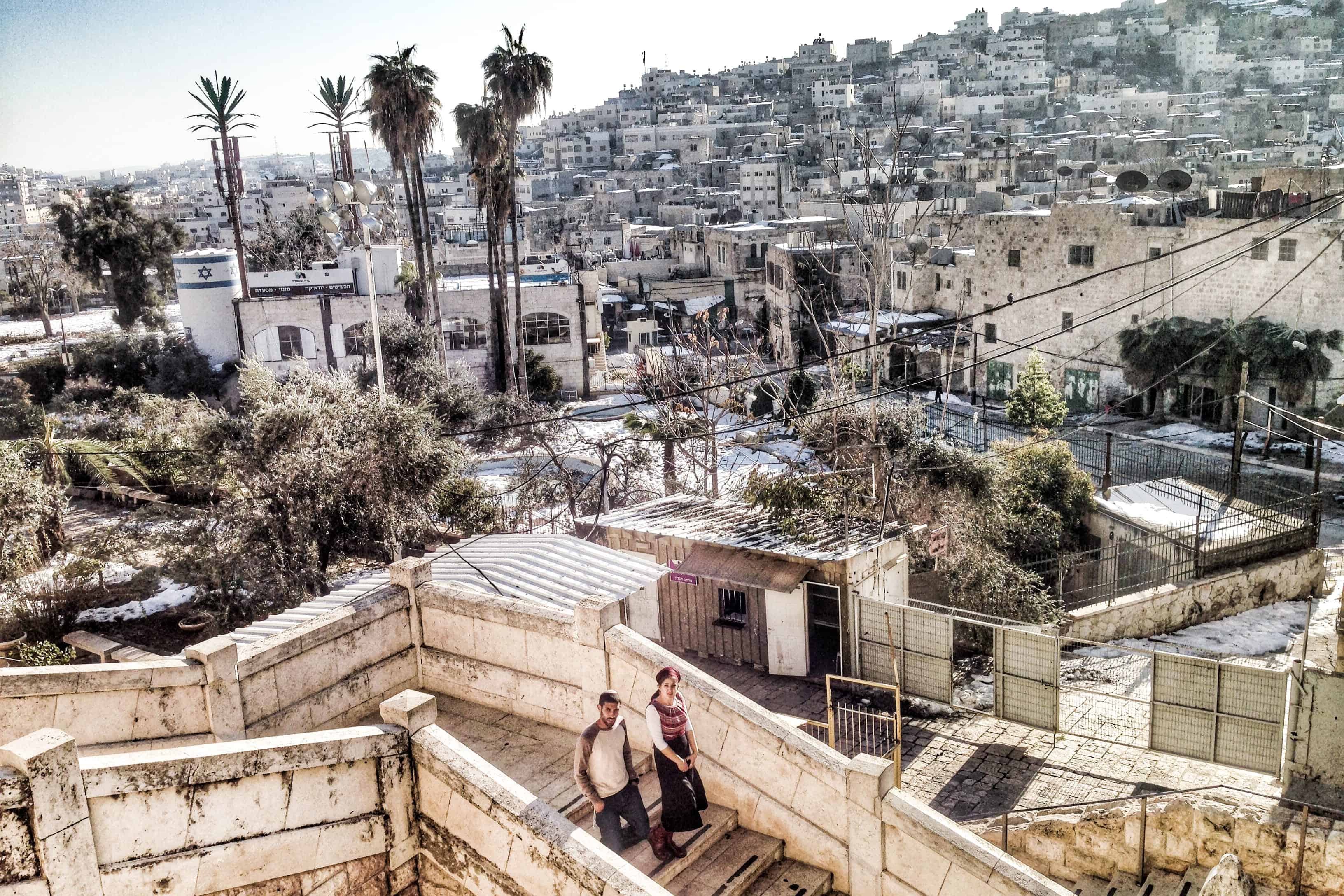

Why Visit Hebron in the West Bank?
Palestine history, the history of hebron, and the west bank conflict in brief, how can you visit hebron responsibly, entering hebron – h1 west bank, entering hebron – h2 west bank, why you should take a tour in hebron, book a tour to hebron and the west bank palestinian territories.
Embarking on a trip to Hebron might sound extreme. Still, a chance to see the West Bank in Palestine teaches you one important lesson that you should carry with you through your days of travelling in this region – that the actions of extremists on both sides are in no way reflective of the people in both countries who go about their day-to-day lives while all this is going on.
A Hebron tourist can, therefore, be said to help bring about the greater good in understanding rather than be put in the same bracket as negative voyeurism.
So next time you call out Israelis for being bullying, gun-touting land-grabbers and Palestinians for being fanatical suicide bombers, remember that there are normal people on the ground who have nothing to do with the wider agendas of their governments or religious factions but who see each other as neighbours and who are calling for the same thing – resolution and peace.
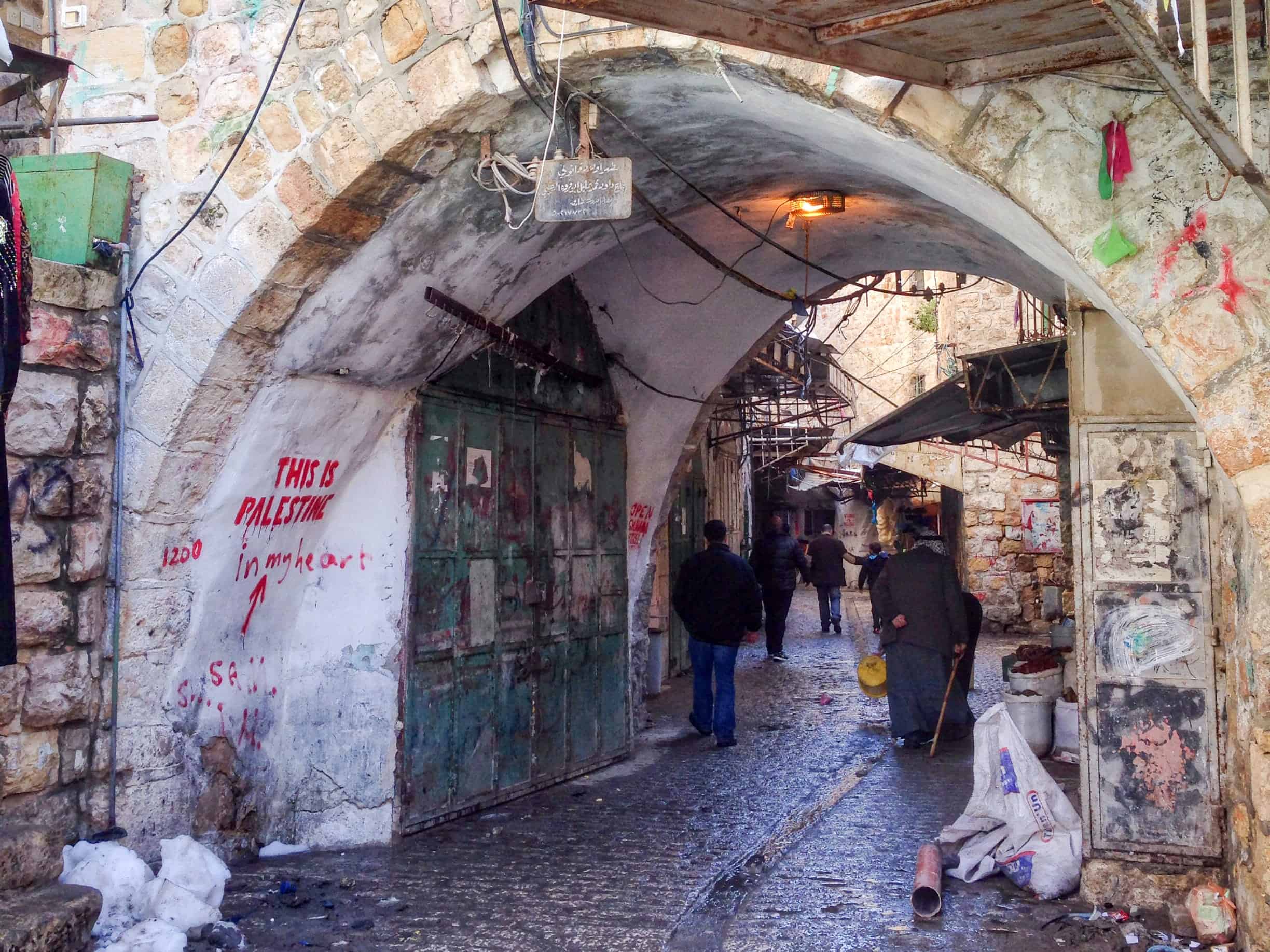
The city of Hebron is at the centre of a divided and troubled Palestine
Where is Hebron?
The divided city of Hebron is the largest Palestinian city after Gaza and is said to be where the settlement movement started – a major issue in today’s ongoing conflict. The meaning of Hebron comes from the Hebrew verb ‘to join’, ironically at odds with its current position where people will always debate if it is Hebron in Israel or Hebron in Palestine. Much of the contested part of its meaning as a Hebrew city comes from Abraham settling there for many years.
Home to over 750,000 Palestinians and around 850 Jewish Settlers, Hebron is split into two areas. Following the Oslo Agreement Hebron Agreement in 1993, which saw the withdrawal of Israeli forces in parts of the West Bank and the establishment of the Palestinian Authority who would control Palestinian cities in the area, Hebron was an exception and given its own terms of the agreement.
Considered the second holiest city after Jerusalem for the Jews, it’s also one of the four holiest cities of Islam (after Mecca, Medina and Jerusalem) and hence control of this part of the West Bank is more complicated.
Here, the Palestinians authorities control H1 (80% of the population). H2 (20%) is controlled by Israel – nearly 750 Palestinians live here alongside approximately 850 Jewish settlers and 2,200 Israeli soldiers. Over time the Palestinian population in H2 slowly decreased following rule, curfews, restrictions on movement, the closure of Palestinian businesses and commercial outlets and settler harassment. The Jewish ‘settlers’ are a separate component to the puzzle, governed by their own administration and with their own agenda, but essentially Israeli forces protect them.
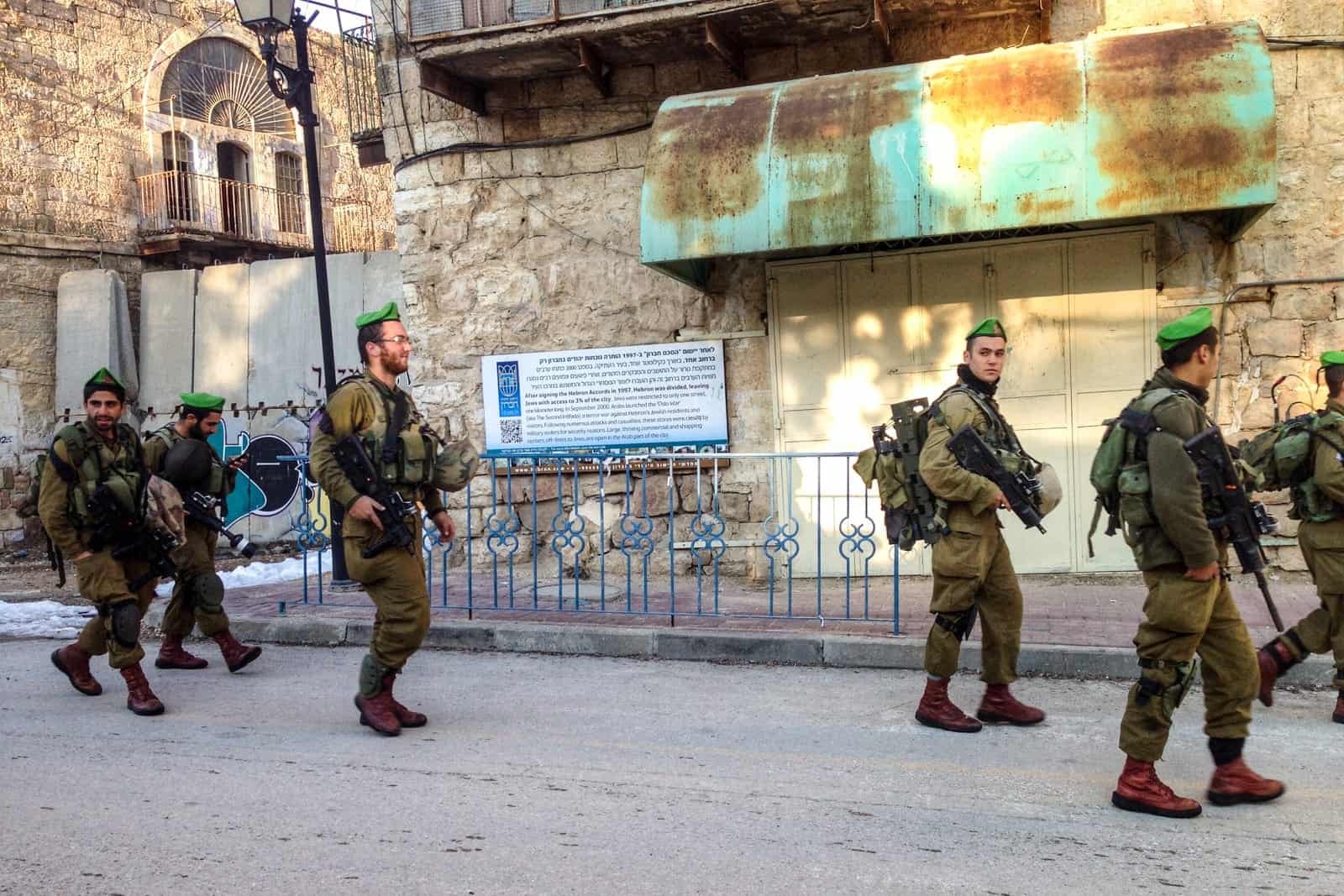
Israeli army soldiers on the streets of Hebron
While you can take a West Bank tour safely and easily, visiting the key cities of Bethlehem, Jericho and Ramallah, this story is specifically about Hebron.
I joined a ‘Dual’ Narrative tour in Hebron, a joint partnership of the Israeli owned Abraham Tours and the Palestinian Visit Hebron-Palestine initiative, where half of the day would be spent with a Palestinian guide and the other half with a Jewish guide. Travelling from Jerusalem to Hebron and back again, is an emotionally compounding day that you won’t forget.
Visiting Hebron from the Arab Perspective
Our Jewish guide, Eliyahu, chaperoned us from Jerusalem to Hebron, which is easy enough to get to from Jerusalem’s central bus station via a public, bullet-proof bus, where we were given a brief overview of the history and present-day situation. On arrival, we immediately met our Palestinian guides, leaving Eliyahu behind for a few hours while we were to go to H1 (he, being Israeli and unable to enter).
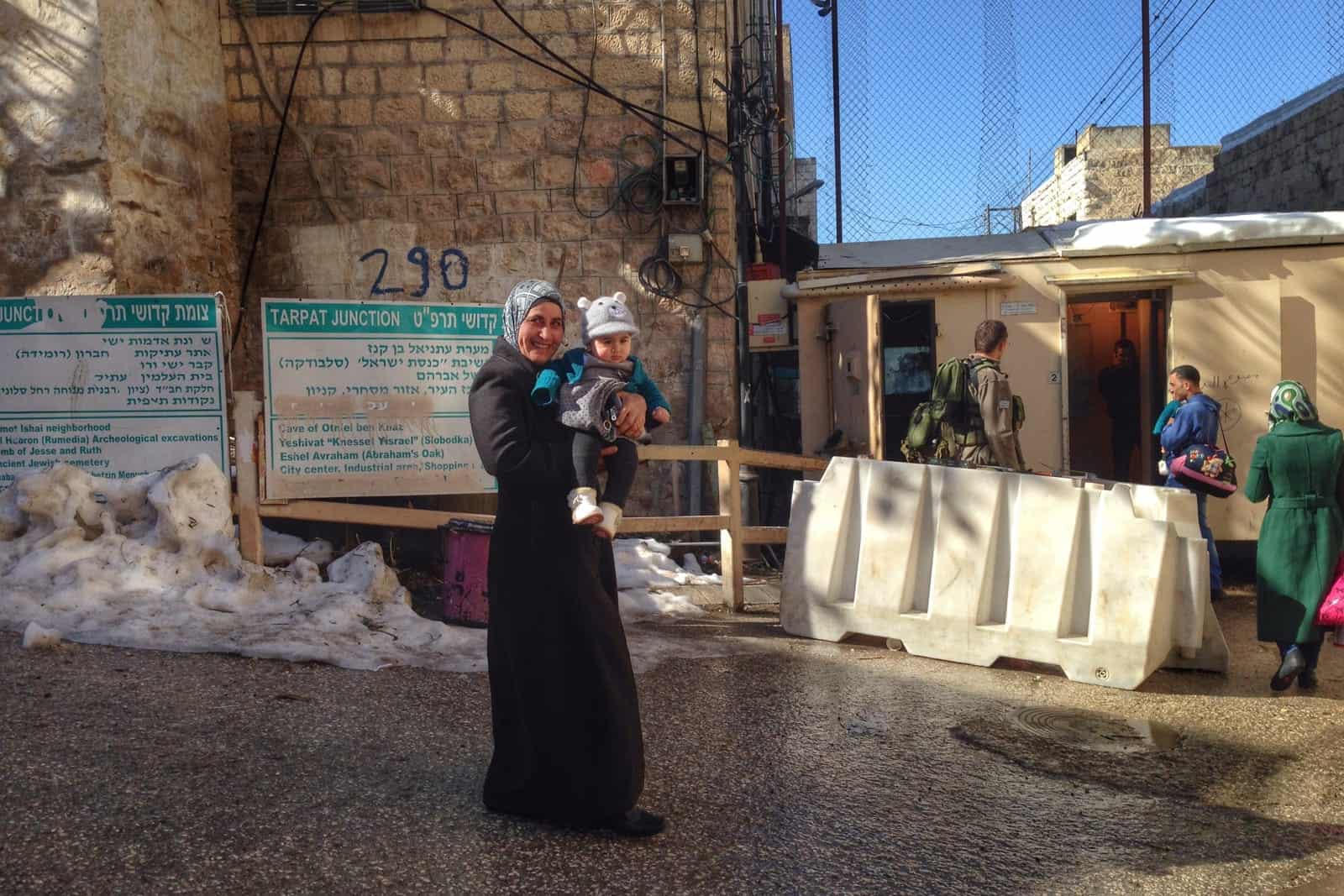
Israeli checkpoint in Hebron, where you can cross between the H1 to H2 sides
We met our two Palestinian guides, Mohammad and Leena, on what is called ‘Apartheid Street’ (Shuhada Street) – given that name by Palestinians since they are barred from using it and being seen as a space of protection by the Israelis.
Once a thriving shopping lane, and now an eerie empty space, you feel the atmosphere here as you wander slowly past the closed shops towards the simple yet daunting checkpoint at the end, guarded by the heavily armed Israeli military. It made the seriousness of the situation all the more real.
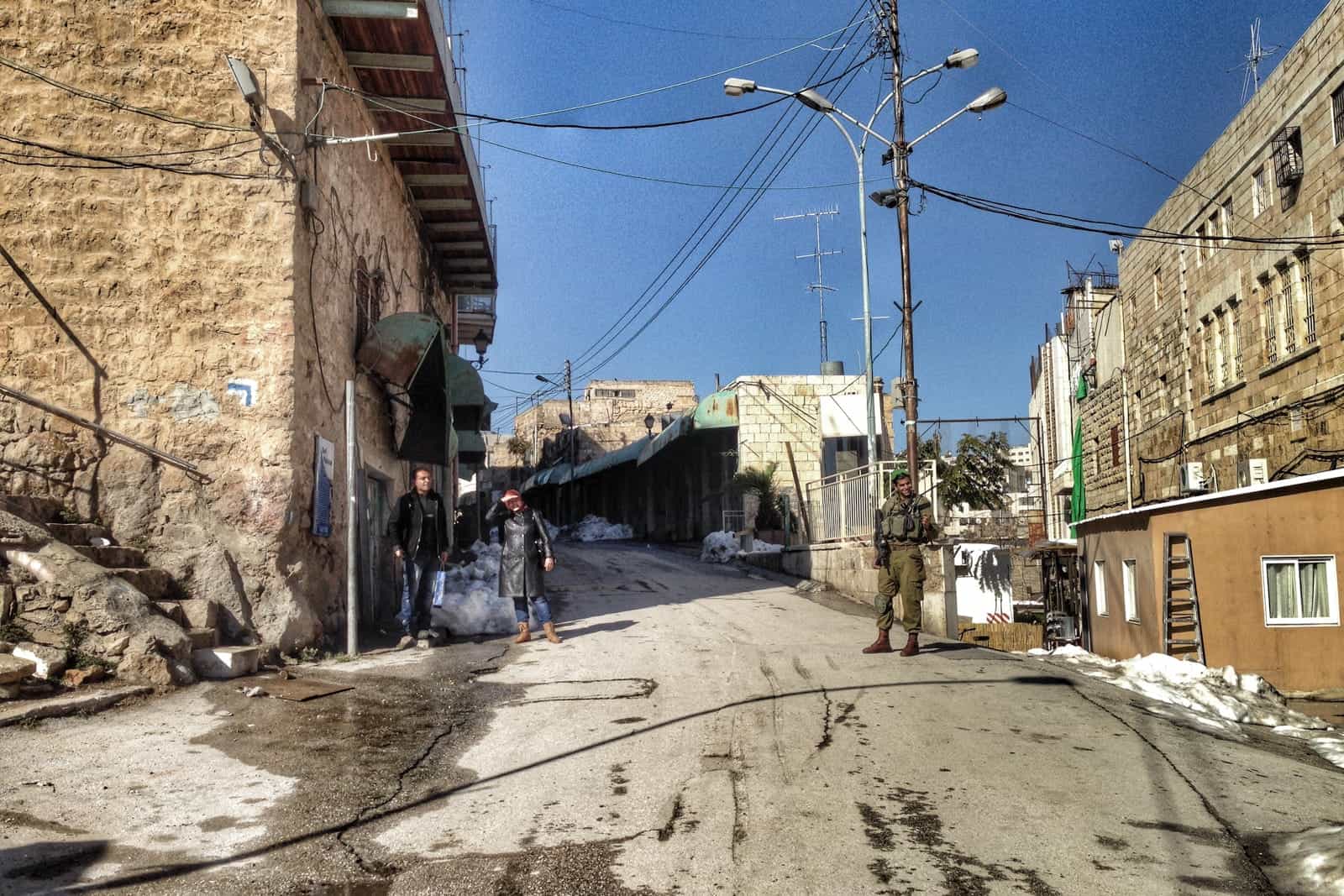
Entering the Arab side of Hebron on ‘Apartheid Street’ (Shuhada Street) on the Dual Narrative tour
Crossing through, we entered another world – a chaotic old city full of cars, bikes, food carts, and throngs of people. We were told it was once a ghost town, but then the Palestinian government implemented initiatives to encourage people to return to this old part of the city.
We meandered the bazaars and spoke to locals, many having closed their businesses and others desperately holding onto those their fathers and grandfathers had once set up.
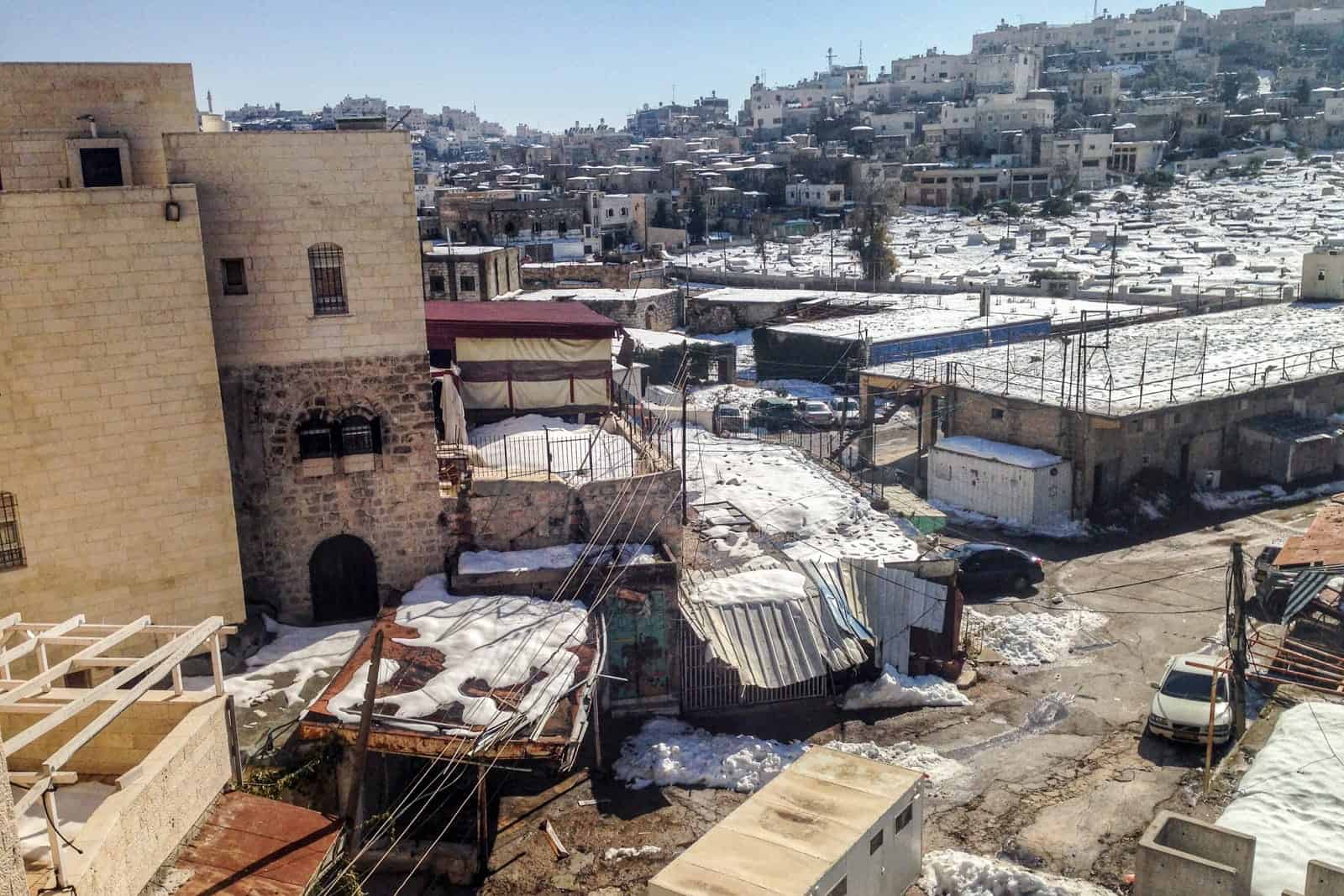
Overlooking the divided city of Hebron in the West Bank
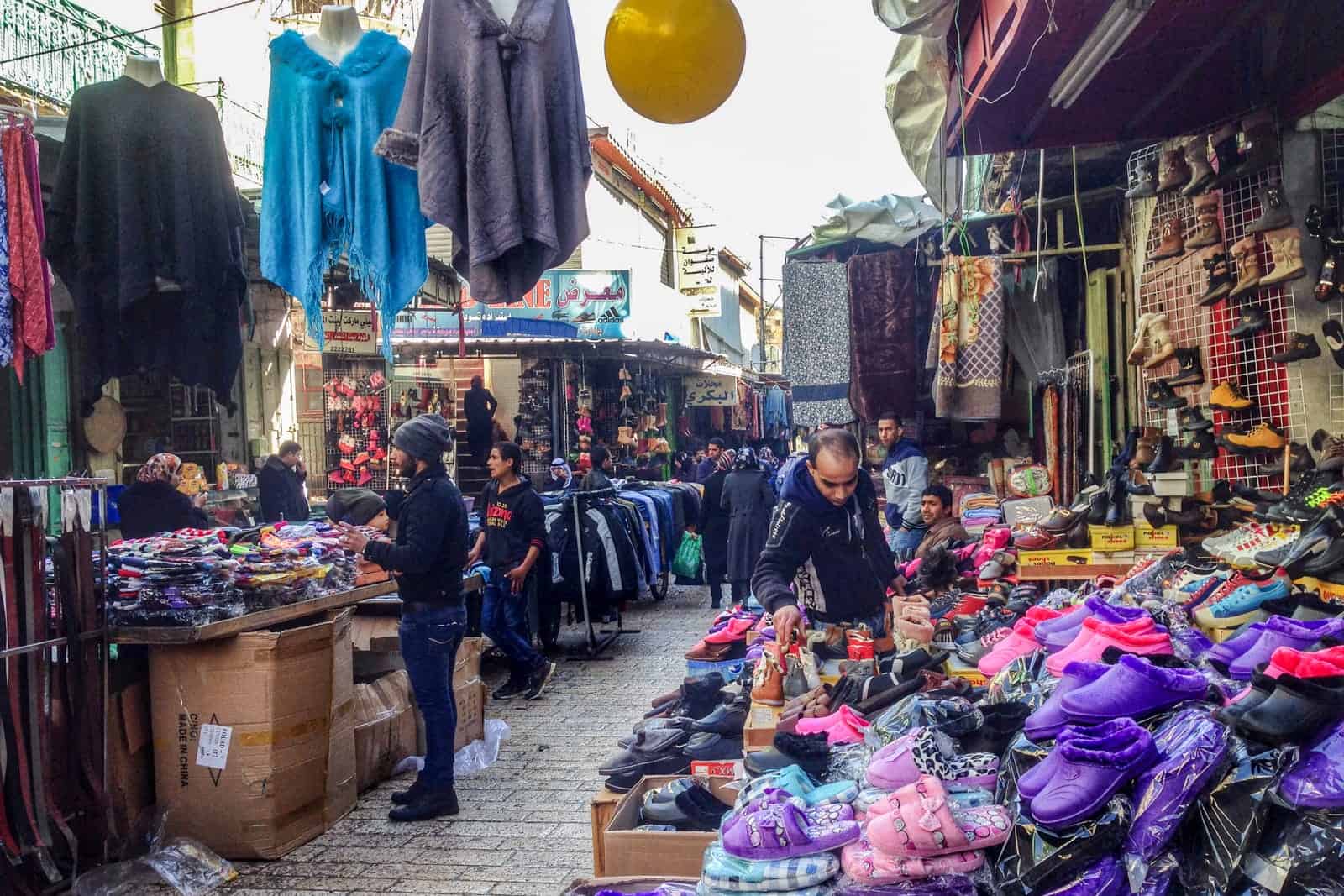
Life in Hebron
I never once felt unsafe here, and nor do the Palestinian people make you feel unwelcome. In fact, many treasure the opportunity to share their stories, knowing that you will share them. But there’s no denying that you could feel the tension, and then we worked out why.
We looked up and saw modern stone buildings standing high above the old crumbling marketplace inhabited by Jewish settlers, the walls literally touching that of the old city.
The thoroughfare of the bazaar was covered in a roof of wire mesh, that had collected stones and plastic bottles like a giant sieve, items that the settlers are said to have thrown below, including urine and bleach (the other side of the narrative is that the Palestinians were also throwing items at the settlers).
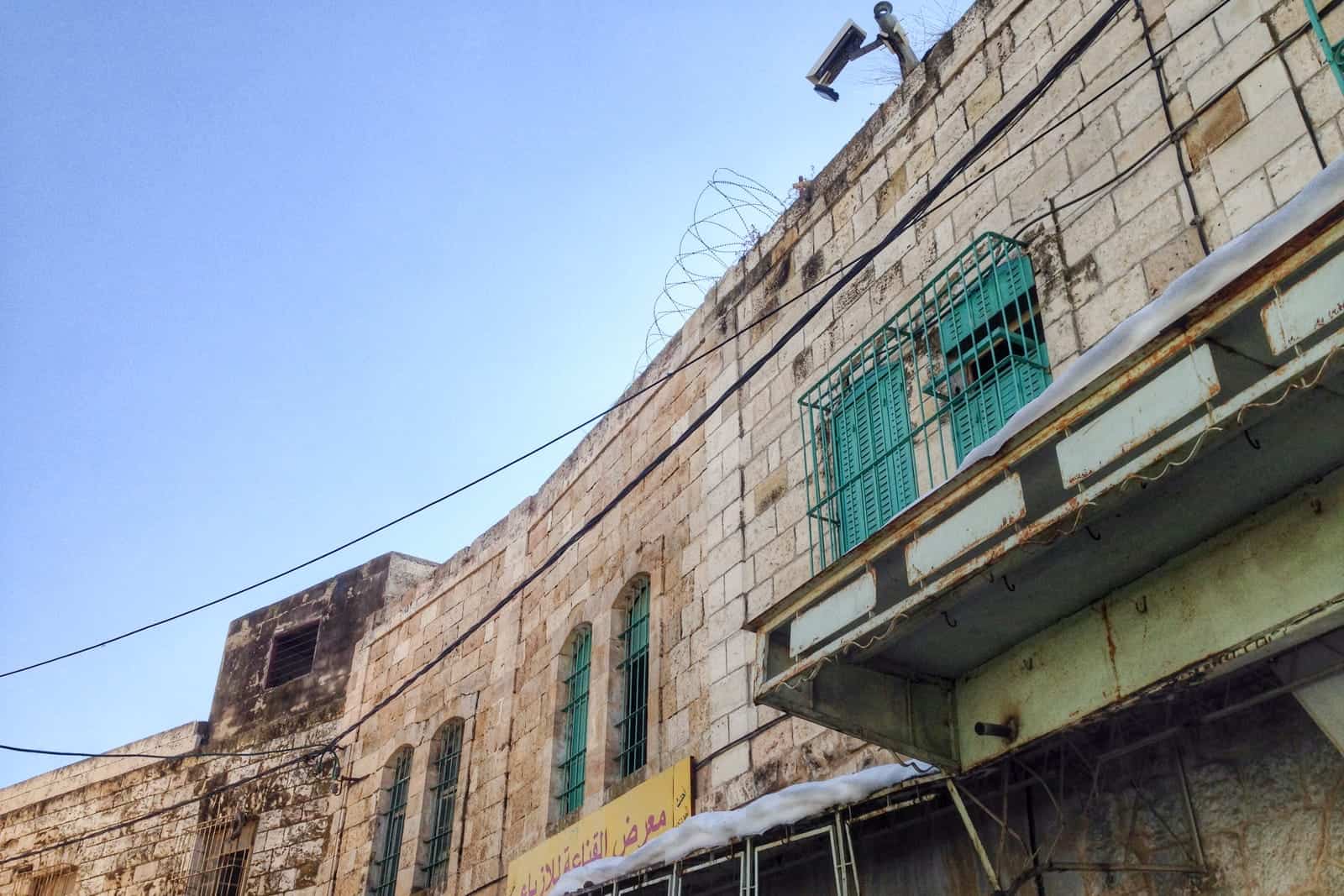
Security cameras from Jewish settlements overlooking Arab side of Hebron
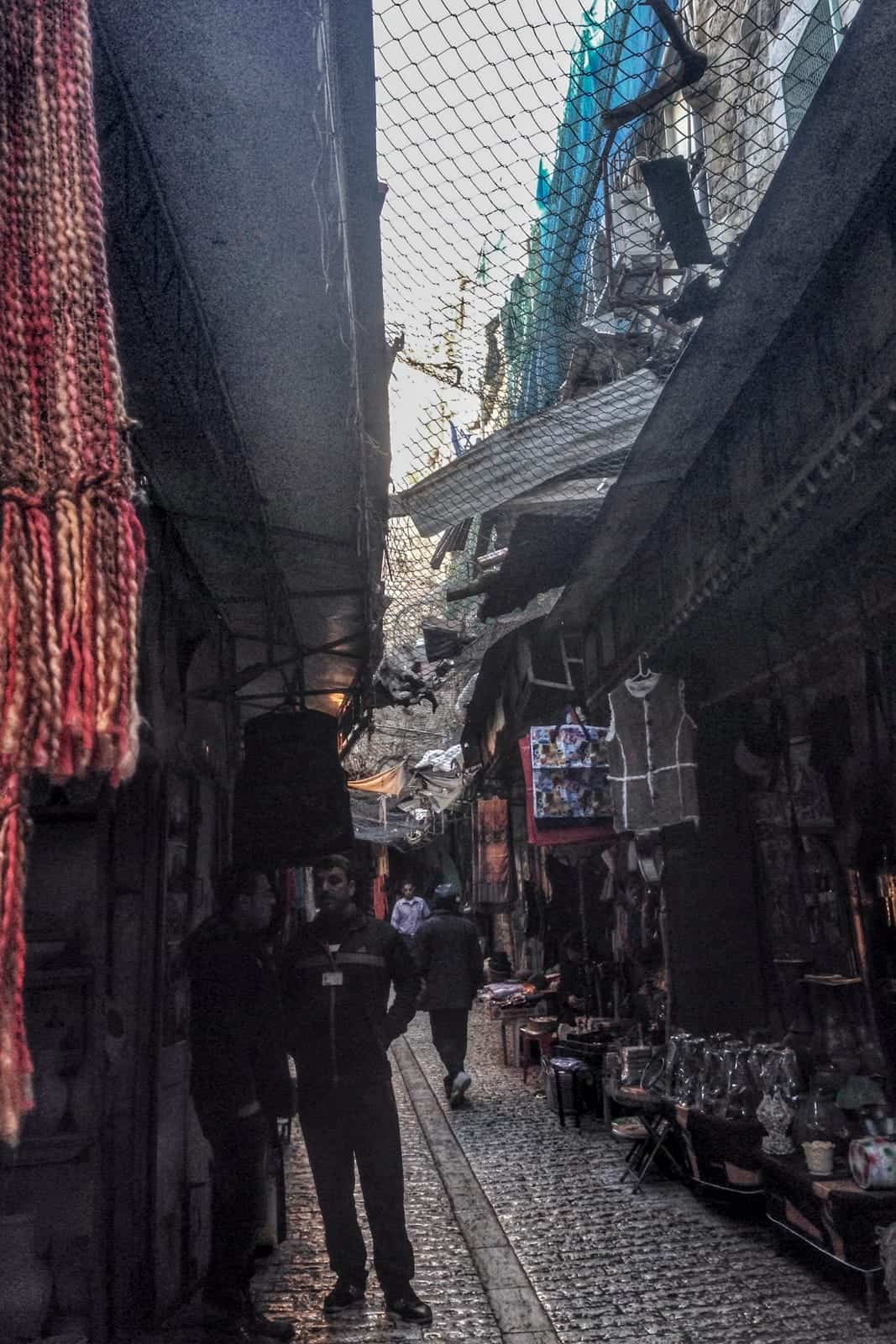
The wire mesh covering the roof of a market in the Arab side of Hebron
We looked around abandoned alleyways and noticed the end of old passages boarded up with sheets of steel, stone, plastic and whatever else could be used to block the entrance… to land now occupied by Jewish settlers.
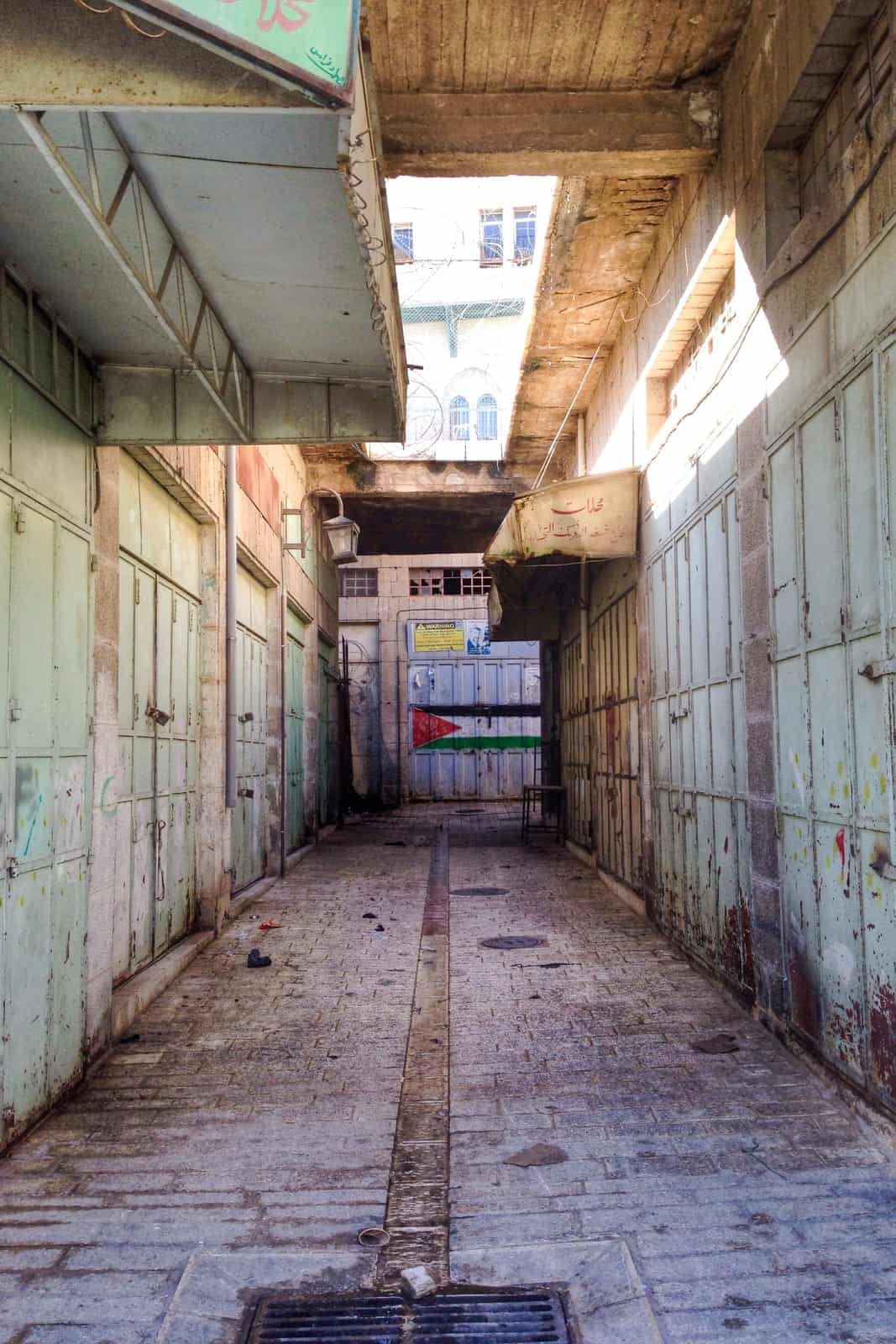
Man-made barriers dividing the two sides of Hebron
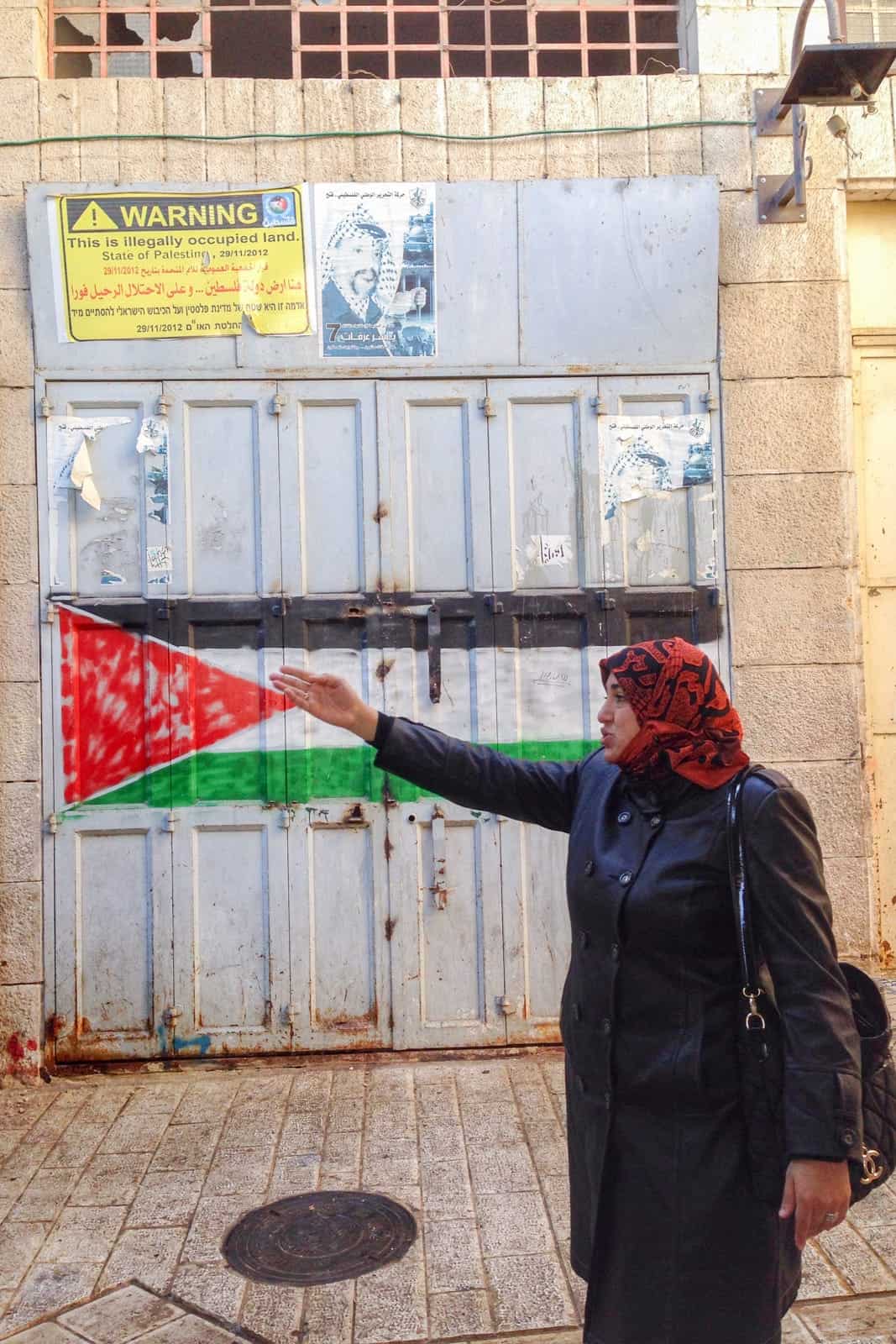
Palestinian guide on dual narrative tour of Hebron in the West Bank, Palestine
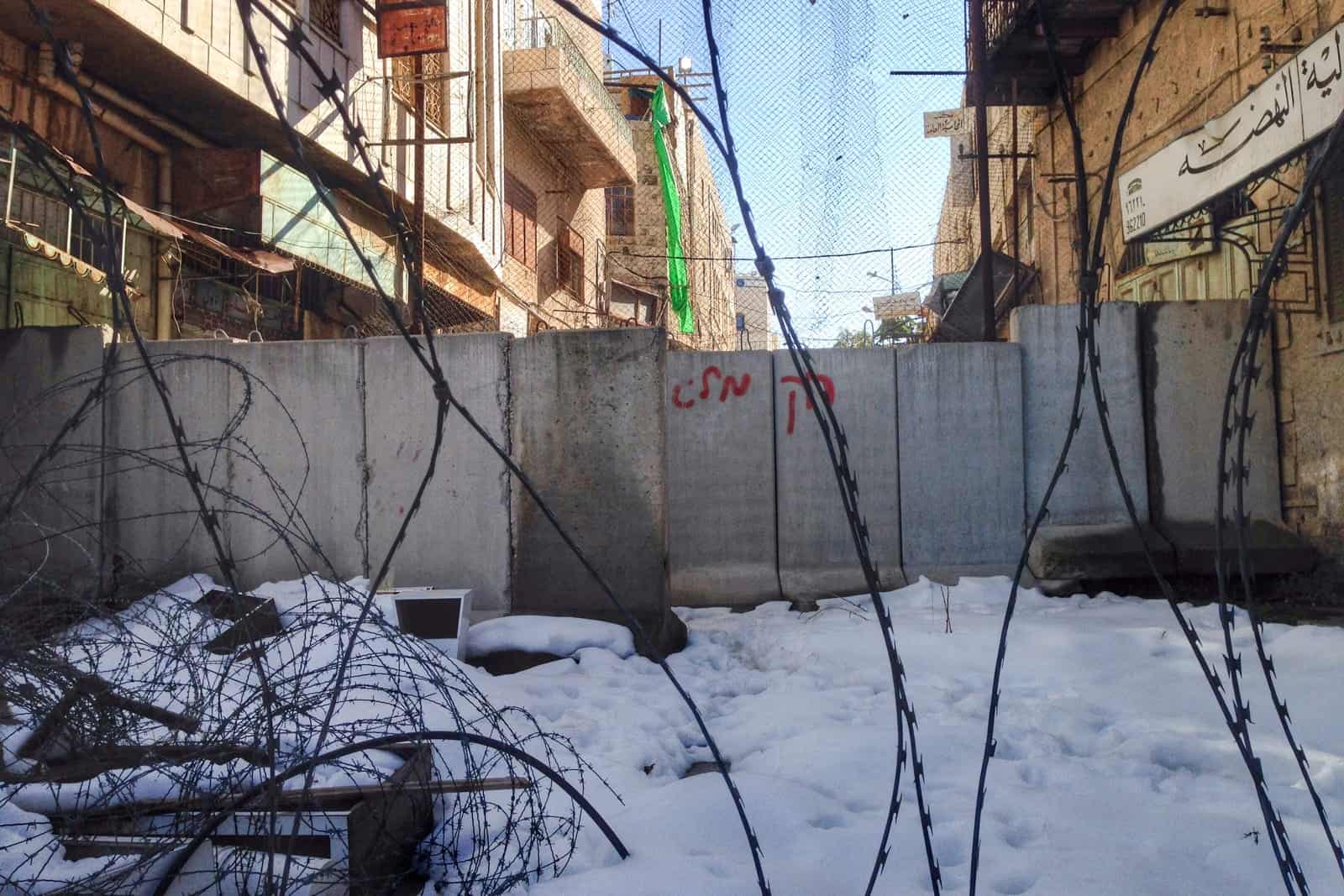
Walls and barbed wire fences separating the Jewish and Arab areas of Hebron in the West Bank
We walked through houses and stairwells to reach the rooftops of local Palestinian properties to find Israeli checkpoints all around us, where armed soldiers took guard on rooftops and hillsides. We were told that Palestinian people are not allowed to lock their doors and that Israeli soldiers could come in at any time. Those houses are taken by force since many Palestinians refuse to sell their properties for the millions of dollars offered by the settlers.
Essentially, they are watched and controlled here at all times, not only with checkpoints but with 100 or more cameras – supervision in H1, which shouldn’t have any Israeli control at all.
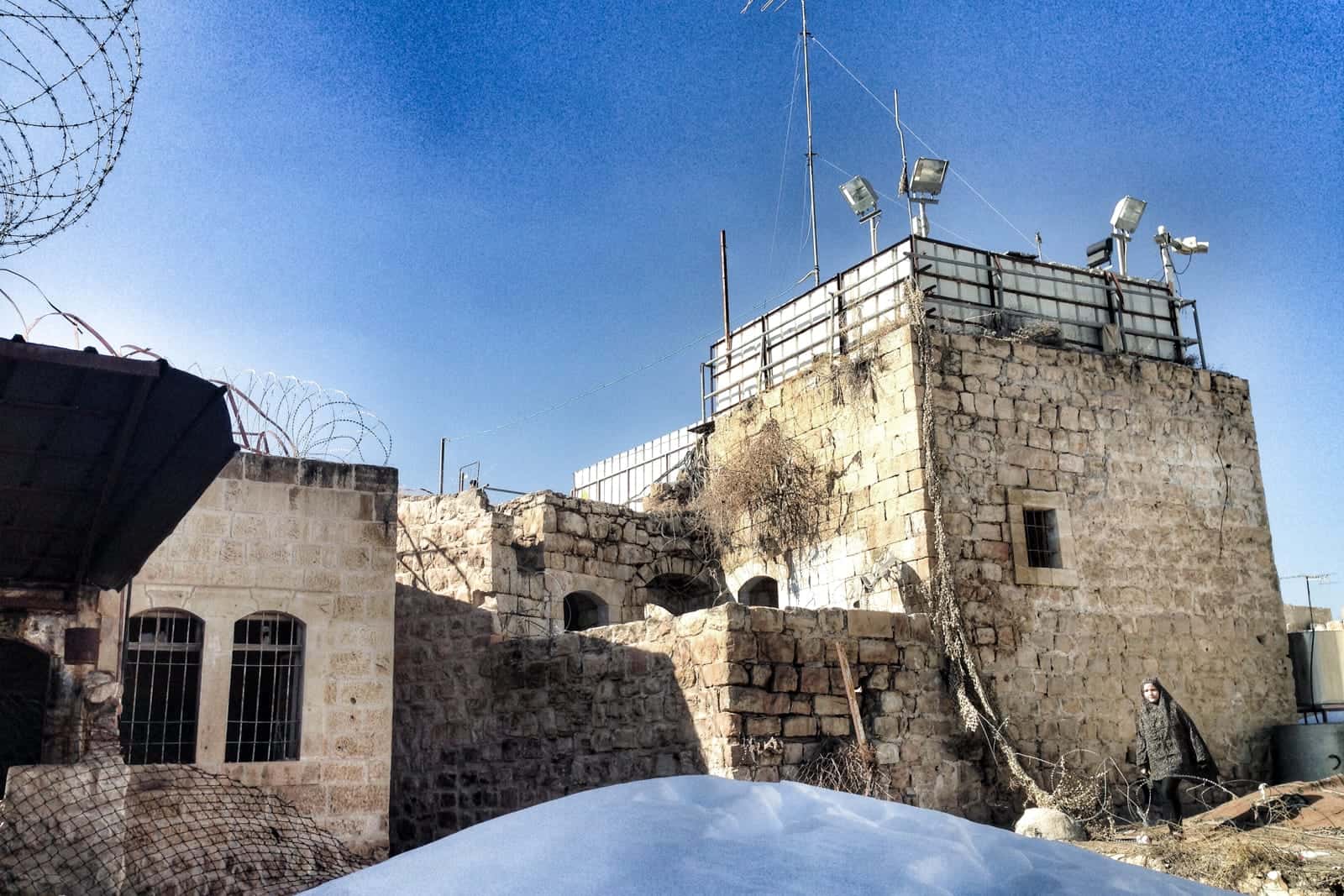
Some of the group cried, and some sat in silence, full of anger, after we had entered the mosque side of the Tomb of the Patriarchs (a place divided in two after a massacre in 1994 that saw a Jewish man open fire on Muslims on Ramadan) and watched Israeli military act disrespectfully. Walking around with their shoes on and the women not covering their heads, many made smirking gestures, and one even curtly told our Palestinian guide to leave the room we were in.
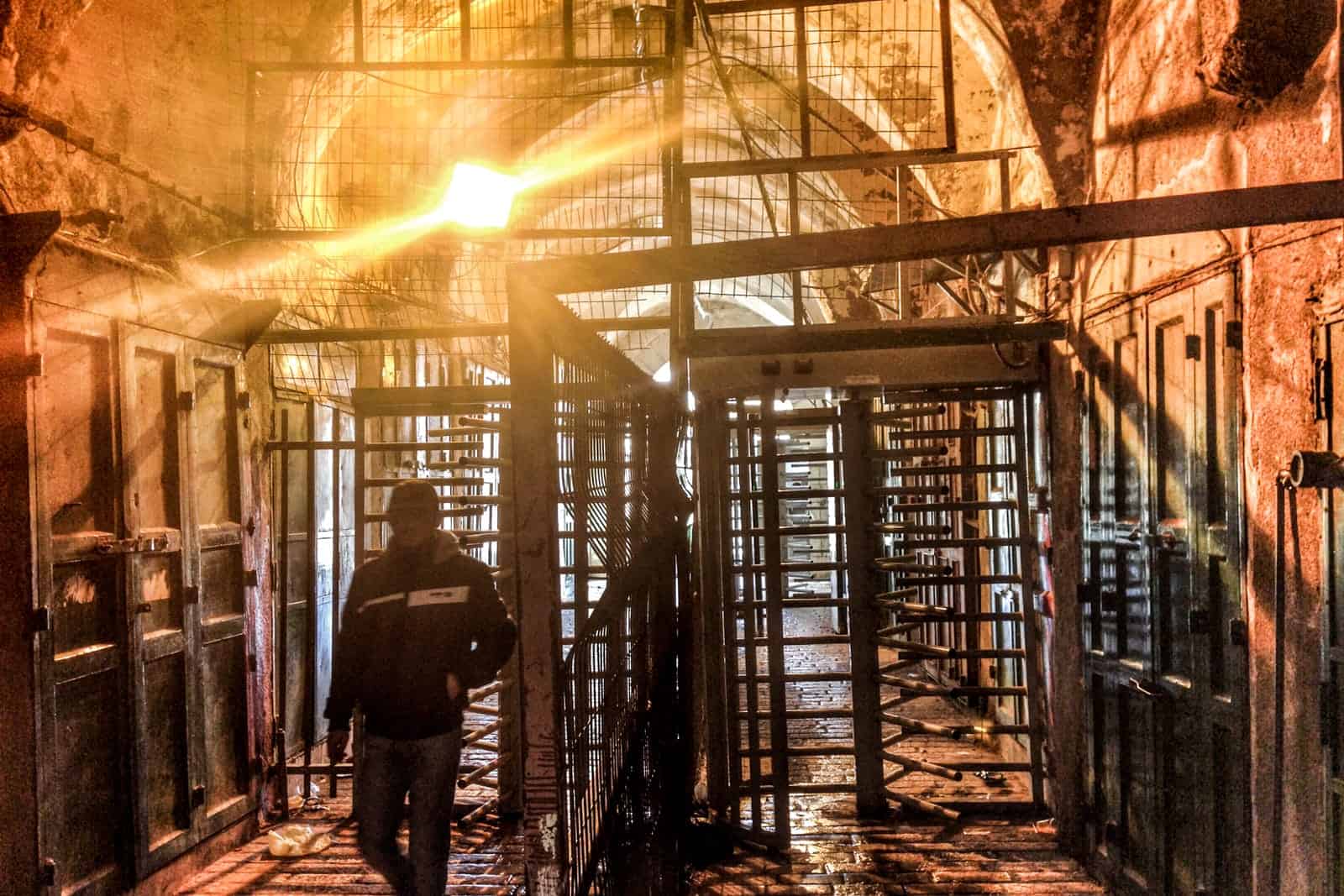
These were not like the Israeli soldiers we had seen elsewhere, and watching Leena break her heart over the whole situation proved that a whole different level of control and attitude exists here, unlike anywhere else. I can only imagine how being posted in Hebron could send you crazy or make you devoid of all rational thought and feeling. However, this is no excuse for the overarching agenda of the system deploying them here.
Our time in H1 ended with having lunch with a Palestinian family, although by this point, we were not in the highest of spirits. All we could do was watch the happiness of the children playing, hoping that one day things wouldn’t be so bad for them – they are the next generation who can make a change.
We bid a sad farewell to our guides, feeling as if we had known them longer than just a few hours we spent with them and grateful that the insight here wasn’t full of extreme hatred and bias.
We had seen enough to make our own opinions.
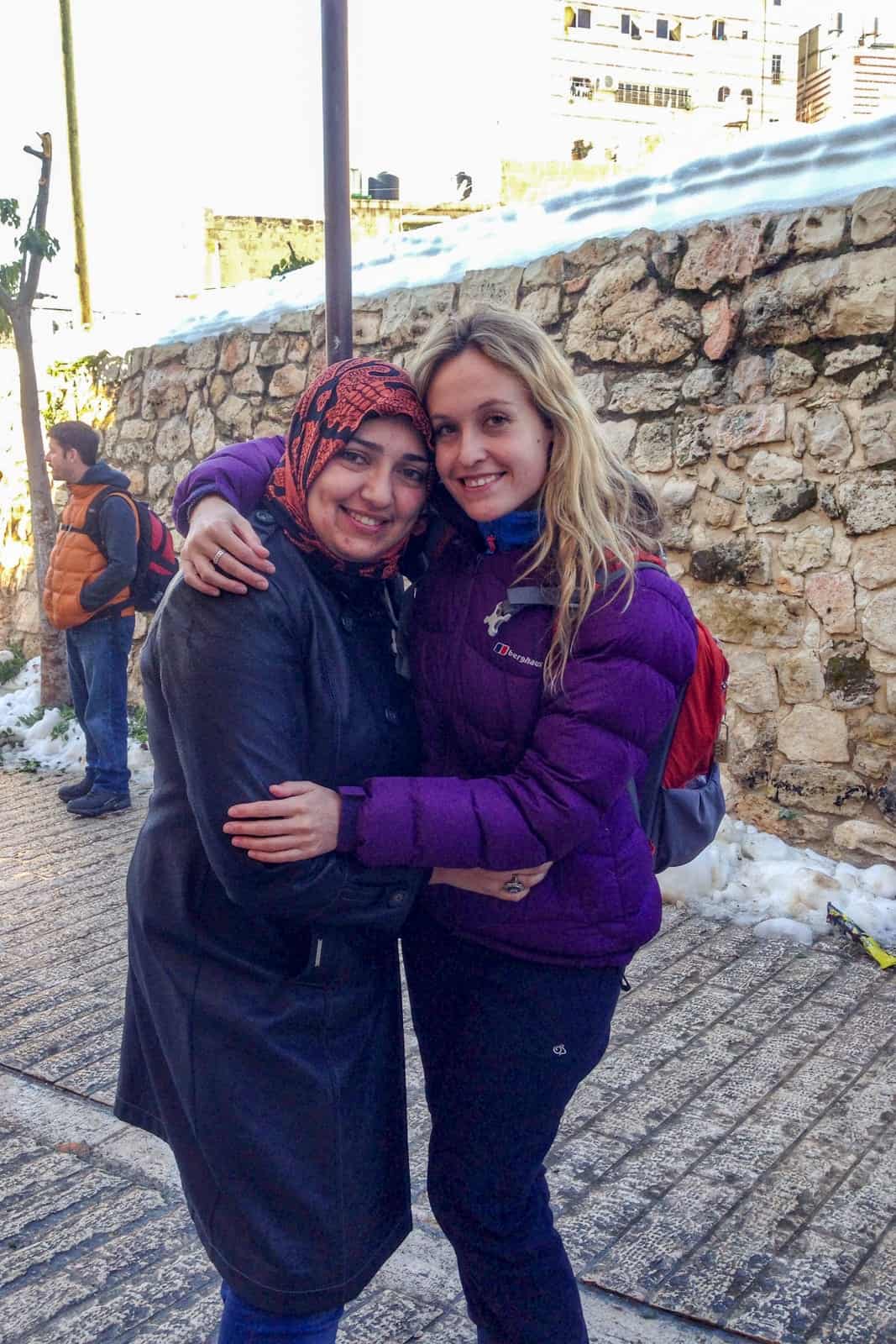
Visiting Hebron from the Jewish Perspective
It’s fair to say that Eliyahu inherited our group in a bad mood, and we later apologised. At the time we were so emotional that we were almost not listening, or wanting to care what he had to say. But the beauty of camaraderie, which is exactly what this tour forges, is that we all willed each other to give the Jewish side of the story here a fair chance.
We entered the Tomb of the Patriarchs again, but this time to visit the Synagogue side, which was just as beautiful but sadder when you saw how both sides ‘peer through’ to each other, blocked by a bulletproof screen at the tomb of Abraham – the one person central to both religions.
We were told how the entire building is open for 10 days a year under Islamic control and 10 days a year under Jewish control – the only means of sharing this holy site.
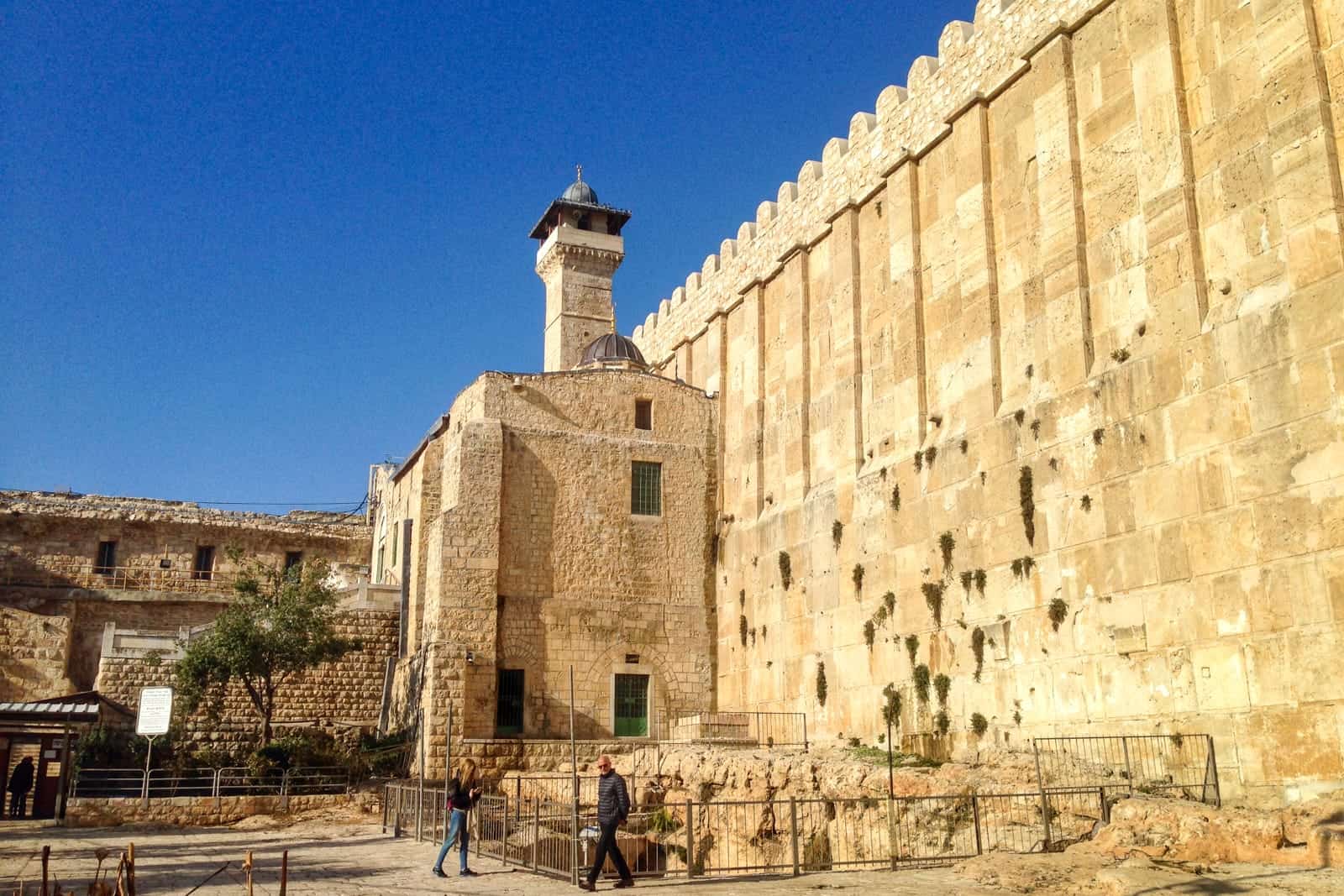
Tomb of the Patriarchs in Hebron, West Bank, Palestine
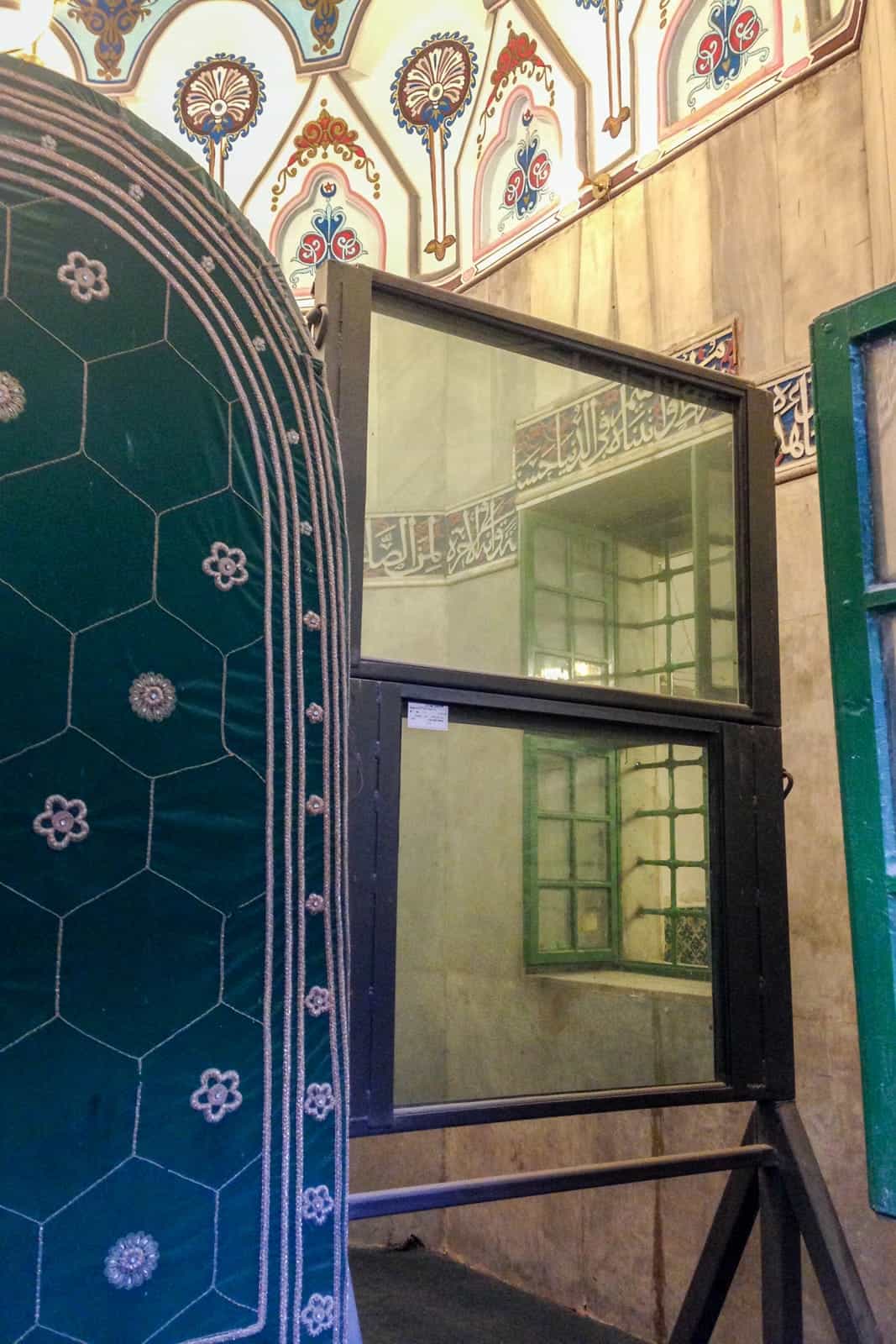
Tomb of Abraham with a bulletproof screen
Visiting a residential area, we learned about the reasoning of settlement here, which is basically about the ‘reclamation’ of land (with archaeological sites used as markers also) based on the heritage of forefathers that dates back to Biblical times, as is the reason used now for settlement in other parts of the West Bank).
A synagogue has even been rebuilt here on the original site (again, as history claims). You get to visit that also.
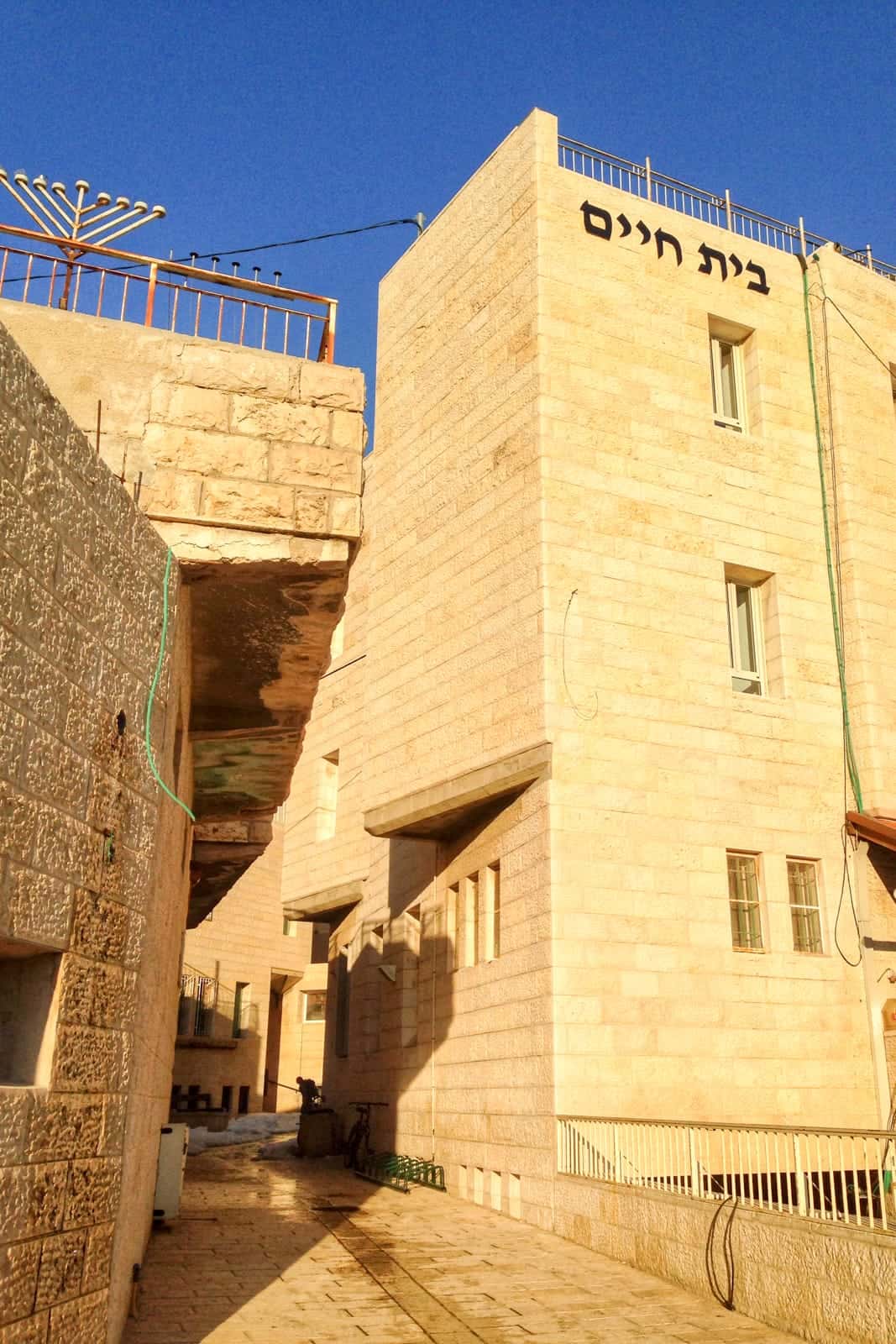
Jewish Synagogue in Hebron
To add to that, there’s also what we were told was “the Zionist response to a terror attack” which is to rebuild where an act of terror took place, and we saw many buildings that had been erected bearing plaques with the names of those who had died at the hand of suicide bombings.
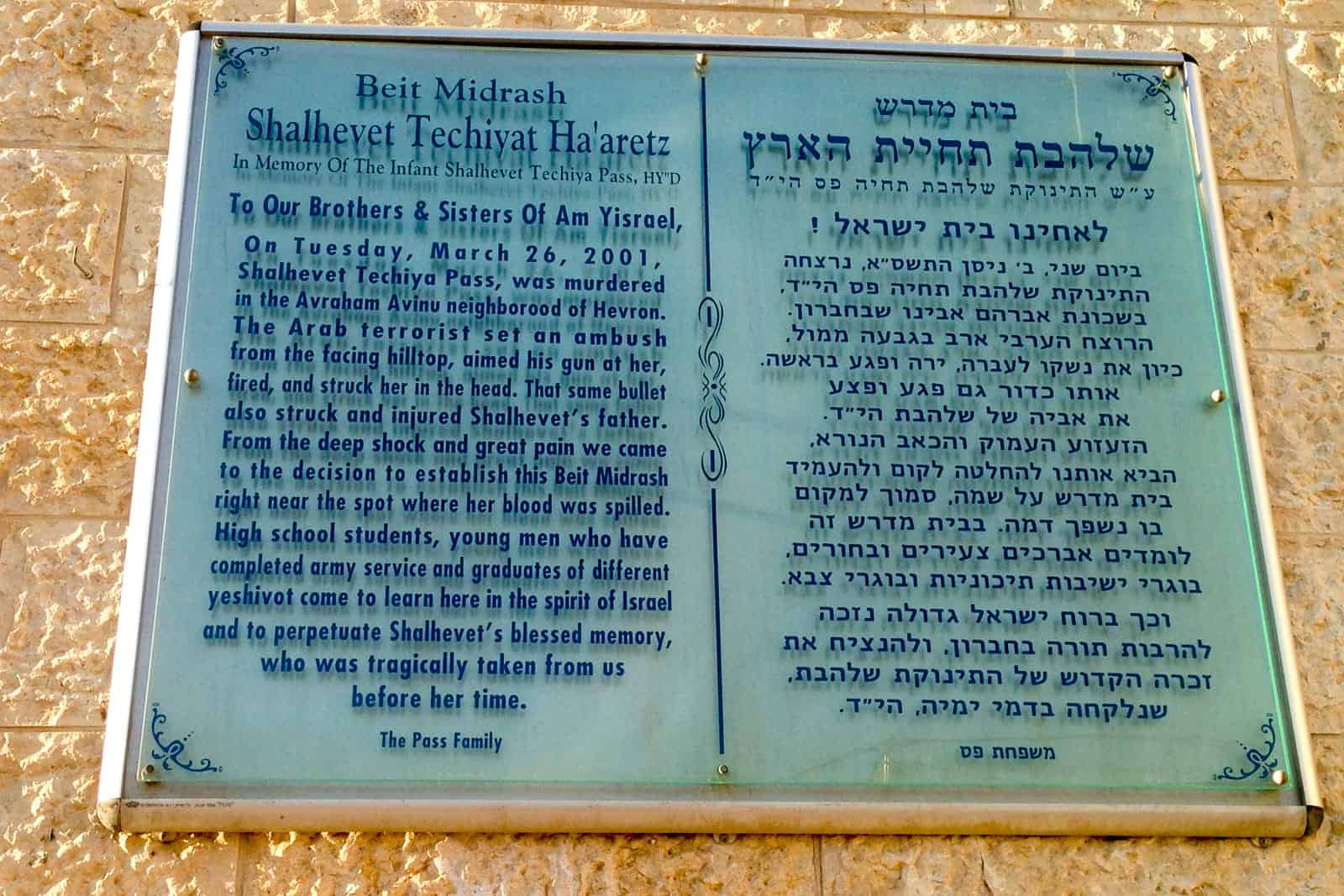
Visiting the Jewish Museum, we were told about the 1929 Hebron massacre, with pictures depicting the slaughter of 67 Jews and the ransacking of homes and Synagogues by the people they once lived peacefully alongside – their Arab neighbours.
This terrible event is seen as an open wound and another reason given for the current Jewish presence here – it is seen as a form of resettlement after they fled the area because of it. However, as pointed out by Eliyahu, the museum is somewhat biased, with no mention of the 400 or more Jews who survived, thanks to their Arab neighbours who hid them and tried to protect them.
It’s fair to say that there’s been a continuous Jewish presence in Hebron throughout history (as with the Holy Land as a whole), but with Jewish people moving out after the massacre and returning decades later.
However, whether or not the Jewish people living here now have a direct ancestry line to those who lived here decades and centuries before, the issue is not with Jewish people as a whole (again, we have to be careful not to categorise ALL Jewish people in Israel), but with the strong nationalistic sentiments of this particular strand of Jewish thought – the ones who firmly believe they have a right to be here, despite rational thought and the idea of coexistence.
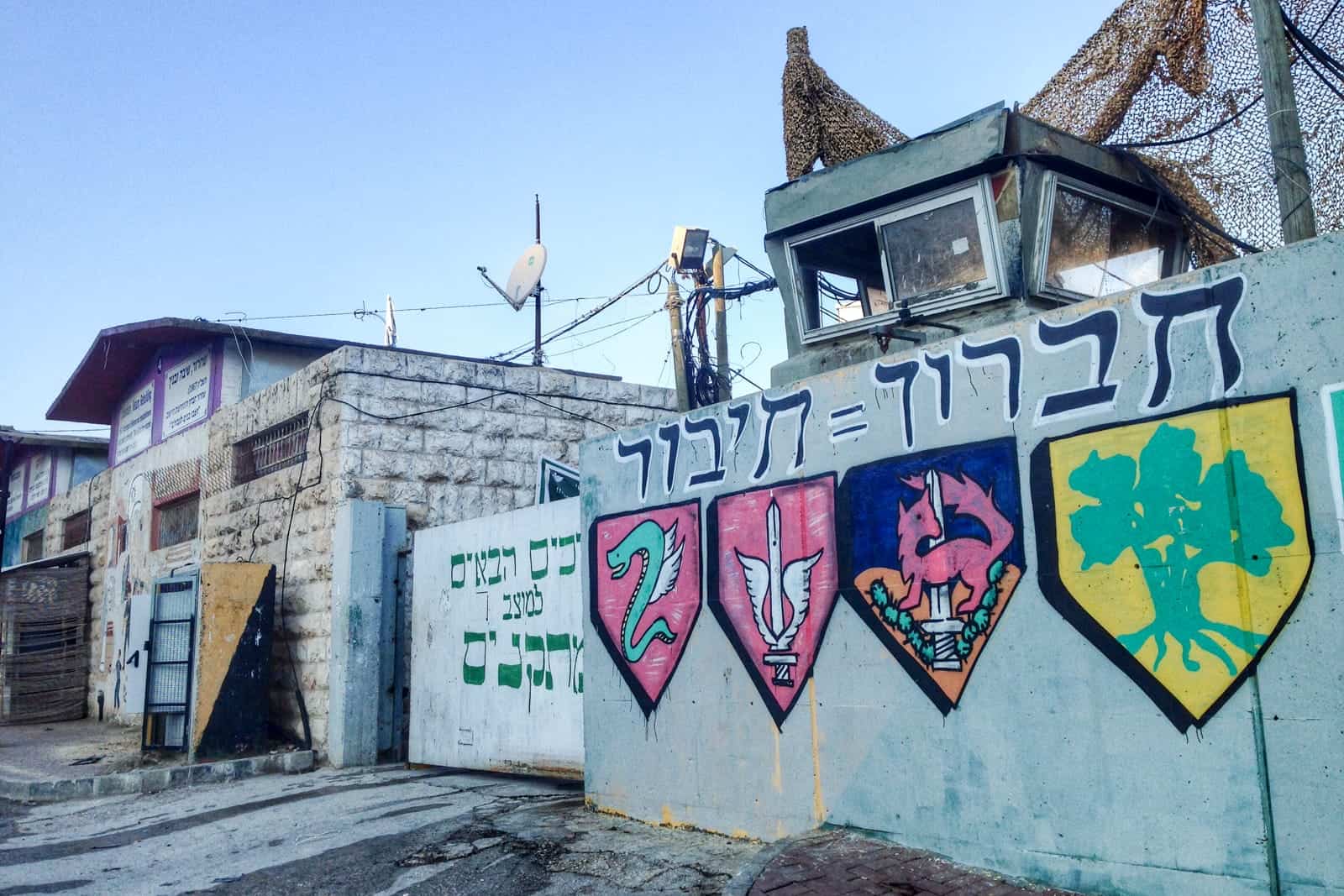
Israeli army building in Hebron, West Bank, Palestine
We ended our time up on a hill, on another Jewish settlement where a Jewish man had been murdered, resulting in the Israeli government granting permission for the settlers to build there. There are so many fractions of settlements in Hebron, each with its distinct reasons to build in a particular spot.
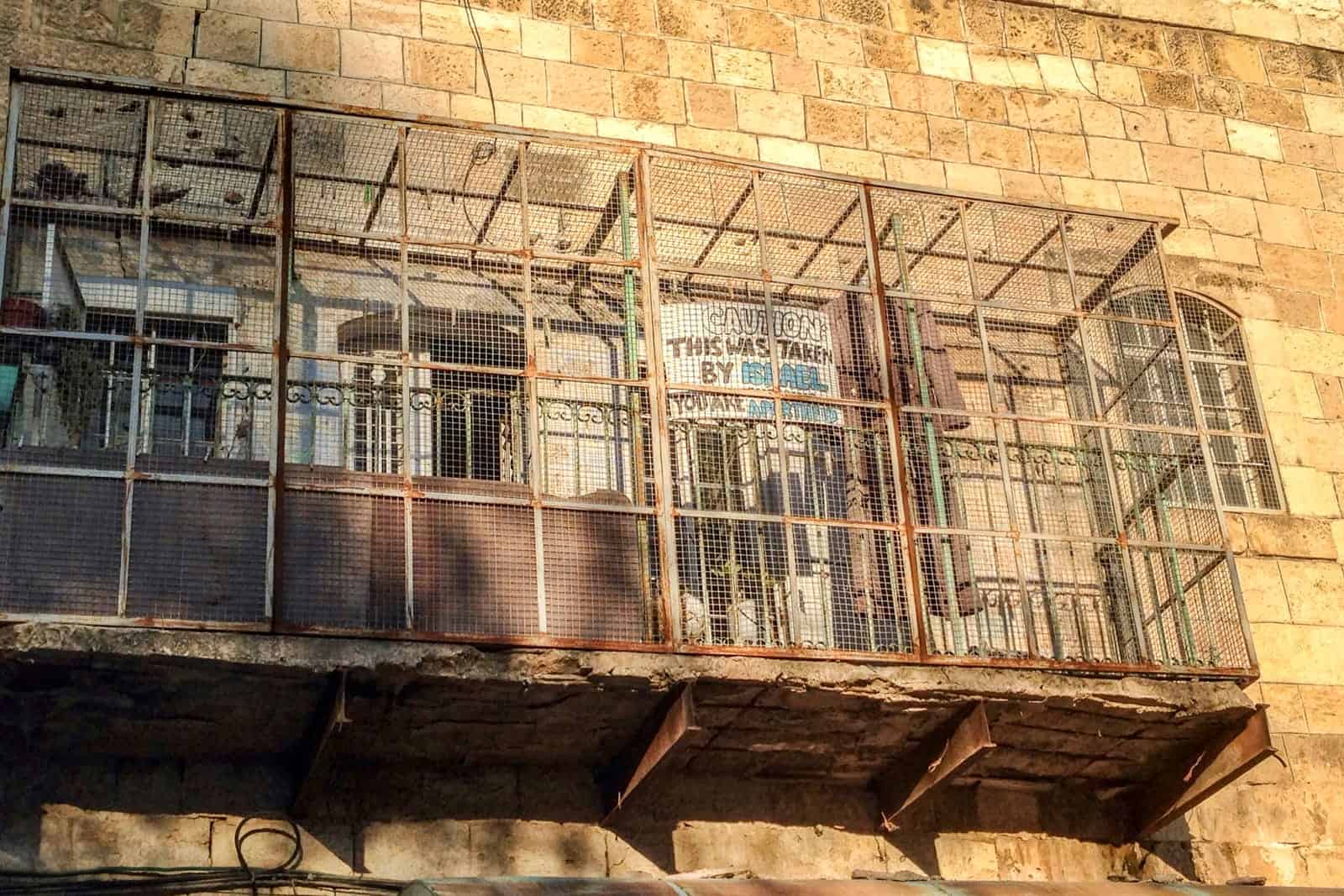
By that point, we had seen and heard enough. We understood both sides, but it didn’t mean we had the answers to everything. It just helped to give perspective on what is possibly the most complicated issue many of us had ever heard about.
But for a few minutes, we stood on that hill and looked out across the spectacular Hebron landscape – beautiful, peaceful, and laden with history. For a few minutes, It was almost as if nothing was happening there at all.
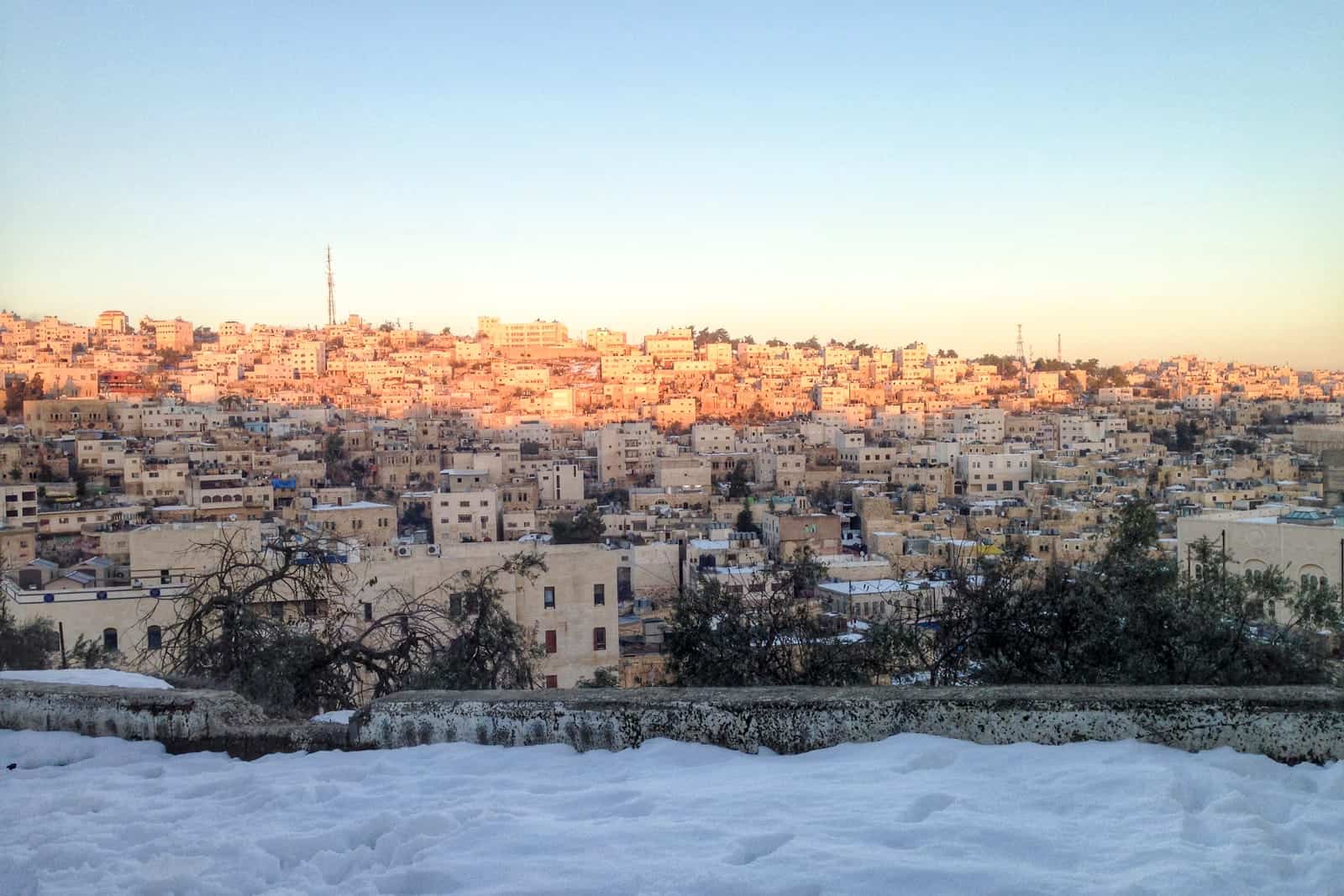
Jewish settlements in the West Bank, Palestine
After the long, emotional, but thoroughly insightful tour, many left to head back to Jerusalem. Five of us chose to cross into H1 again to meet Mohammad since we wanted to see the new Hebron – the modern side of the city away from the heart of the conflict and Israeli control – a city very much like the other cities in the West Bank, full of stores, restaurants, and other big businesses.
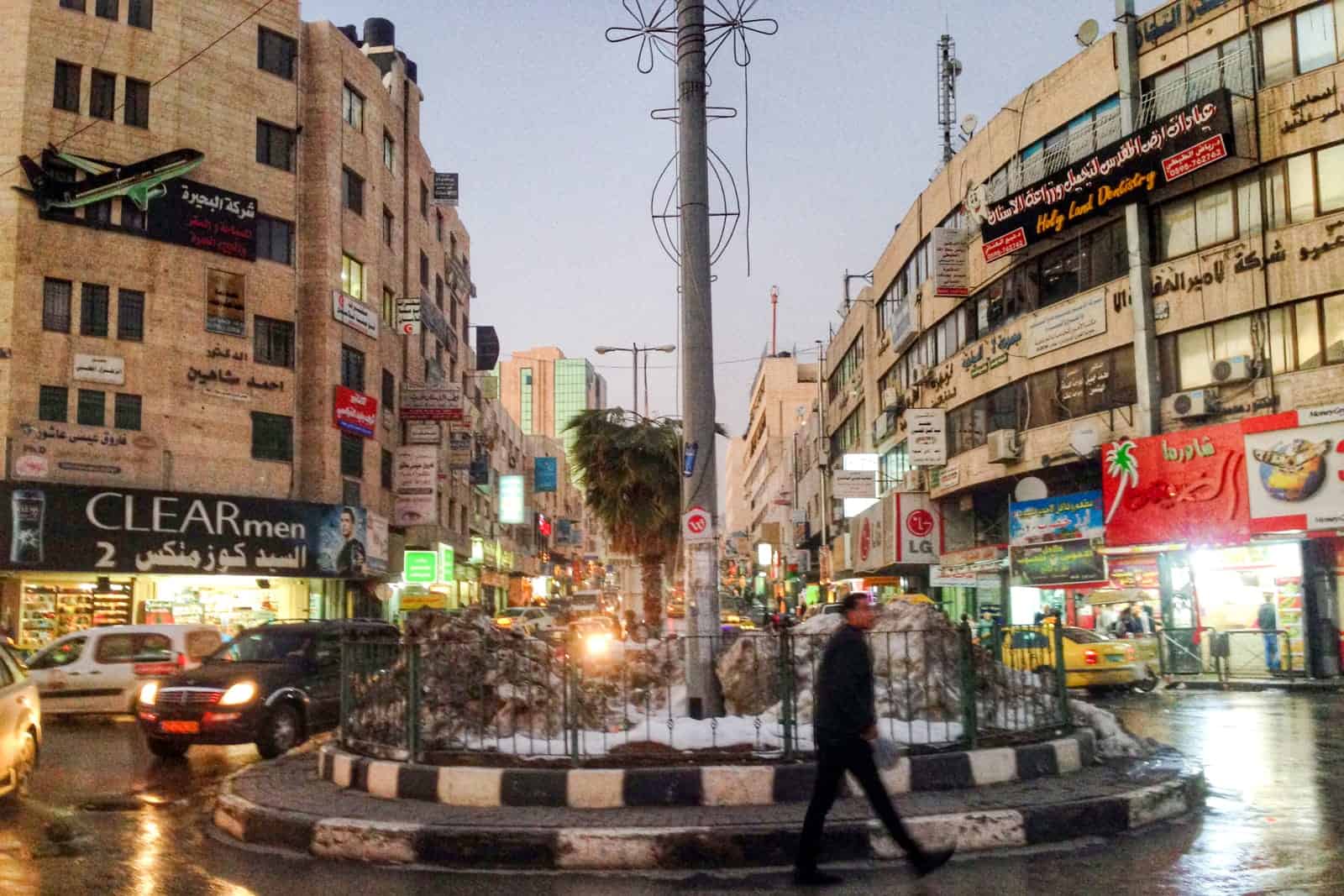
Hebron at night, in the West Bank
We tried local coffee and indulged in a hummus feast before getting on a bus to Bethlehem to cross the border back into Israel. None of us will forget that quality time with Mohammed, our new Palestinian friend, knowing that we would return to Jerusalem to do the same with our Israeli friends that same day.
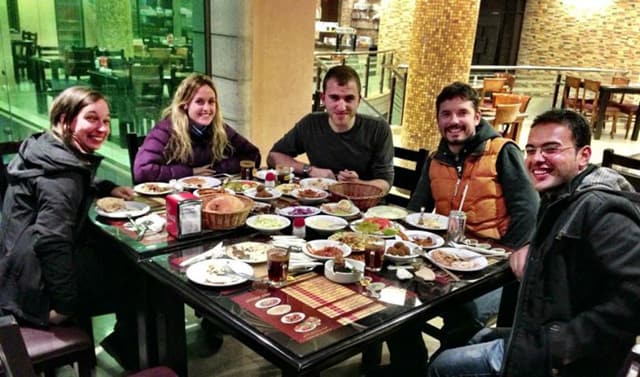
Friends in Hebron
Maybe one day, we will all get to sit around the table together in both Hebron and Jerusalem without the need for divisions, checkpoints, and explanations. Maybe one day we can unravel the history of Israel and the history of Palestine and find some common ground.
That’s why these Israeli and Palestinian people are working together, after all – to prove that peaceful communication is possible.
Whatever your opinion, from what you’ve read, watched, or listened to, there’s nothing more important than seeing Hebron to formulate your own.
By actually being here, you become another part of the narrative, and you may well be surprised at how your own fervent, one-sided opinion becomes more balanced and informed.
Of course, there are many strands of narrative, including those of the army, civilians, left-wingers and right-wingers and everything else in between, but I will leave you with these wise words we were told.
“There’s room for all manner and strands of beliefs. Nationalism is poison. The only thing we should condemn is violence but continue to love the Holy Land.”
For all details and to book the Dual Narrative Tour in Hebron with one of my trip partners, Abraham Tours, can be found here .
- The full day tour costs 290 ILS = 69/ $78 / £61 and runs from 8 am until 7 pm.
- You will need your passport in order to cross through the checkpoints.
For an even more in-depth insight into the region consider a Palestinian Territories / West Bank tour that also covers Jericho, Bethlehem and Ramallah , as part of a day trip from Jerusalem.
Visiting Israel and the Palestinan Territories ? It’s contentious, but I outline in my guide why it’s a fundamental means to understand the region from your perspective, and why including a visit to the West Bank is essential in formulating a well-versed picture.
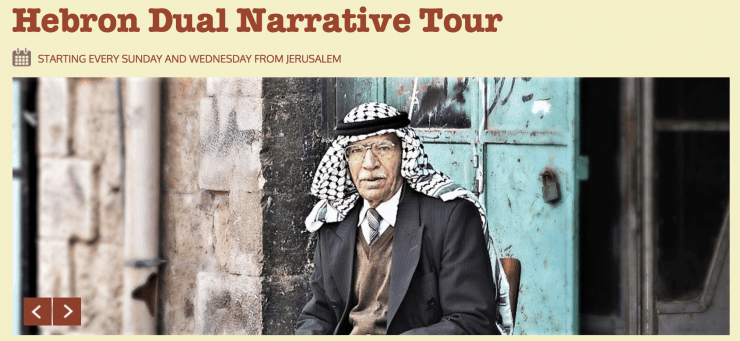
About Becki
Becki Enright is a British Travel Press Award-winning writer whose work focuses on changing perceptions about misunderstood aspects of destinations. Her writing combines storytelling with insight into the social, historical, political and economic factors that shape the country or place in relation to tourism. Becki has appeared live on Sky News and CNN and has contributed to high profile media including National Geographic, Time.com, Guardian online, New York Times, Grazia and Buzzfeed.
Katherine says
31 July 2019 at 12:12 pm
This is the first travel article about Israel and Palestine I’ve read that was actually GOOD. I want to express my appreciation for your writing. I sincerely agree with most of your views. Issues of identity become bigger problems when they are used to promote nationalistic agendas.
22 October 2016 at 6:00 pm
Thank you for this interesting and insightful article. It is refreshing to see how you really tried to show both sides. Amazing that such a tour is offered in this area! I just wanted to mention one thing: The reason the soldiers don’t take their shoes off at a mosque is that it’s a security issue. Putting such a shoe on and taking it off takes quite some time ( ask any soldier, I think it’s the same no matter which army) and in this time they would be vulnerable to an attack. As you say there’s a lot of tension there and they don’t want to risk anything. Thank you also for the great pictures, it really makes a difference to see how the place looks instead of only hearing the name!
- Article Archives
- Work with me
- Privacy Policy

Dual Narrative Hebron Tour: Don’t Leave Israel Without This Experience
I glanced at the window beside me; a fractured kaleidoscope of colours reflected by the scenery outside. Tiny cracks spider webbing out from the point of impact in the middle crawled across the entire window pane. I wondered what had made the window crack like that. I hoped it was a rock, but I also recognized that it could have just as easily been a bullet. After all, we were on a bullet-proof bus headed to the divided city of Hebron; a city known for conflict and violence. This was the dual narrative Hebron tour and I knew that by the end that the cracked window pane was only the beginning of what I would see and hear about today.
*disclaimer: I was a guest of Abraham Tours during my visit to Israel. All opinions are, as always, my own.

As our bus rumbled down the highway, our Hebron tour guide, a friendly expat from the USA, filled us in on what we passed. The gas station/convenience store swarming with soldiers is known to be a small war zone after an Israeli was brutally murdered by a Palestinian. The towering, grey walls beside the highway was the safety wall…at least according to the Israelis. Our guide also told us that the same wall was known as the apartheid wall by the Palestinians. One wall, two completely different perspectives of it.
As we drove through the Israeli countryside, I saw the wall snaking off into the distance and, beside it, barbed wire and an electric fence. We passed several checkpoints off to the side of the road; giant red signs with bold white writing in Hebrew, Arabic, and English:
“This road leads to Area “A”. Under the Palestinian Authority the entrance for Israeli citizens is forbidden, dangerous to your lives, and against the law.”
After about 45 minutes, and several stops where we picked up soldiers, we arrived at our stop. This was as far as our Israeli bus could go. Upon exiting the bus we were faced with dozens of Israeli soldiers, guns held at the ready as they eyed our small group.
And so began our Hebron tour.
*My IG stories of this day trip were of huge interest to my followers so I did save them to include in this article. You can find it below if you are interested.
The Divided City of Hebron

Hebron is a divided city. Meaning that part of the city, H1, falls under Palestinian authority while another part, H2, falls under Israeli Military control. While both sides agree that the division of the city was for the best, it is still an area of dispute and violence with men, women, and children killed or injured on both sides.
Palestinians can visit the Israeli side of the city, should they wish. However, the Israelis cannot enter the Palestinian side. Except for the military, who have declared some areas on the Palestinian side a military zone, forcing the local Palestinians to close up their shops and leave their homes. Additionally, the Palestinians must have special permits in order to make their way through Hebron and navigate the military checkpoints spread throughout the city.
Hebron is not a typical city that tourists would choose to visit. In fact, most tourists don’t know anything about Hebron. However, for those who are interested in learning more about the Palestine-Israel conflict, and seeing a bit of it up close and in person, a visit to Hebron is a must and the dual narrative Hebron tour is the best way to go.
What is the Dual Narrative Hebron Tour

So what exactly is the dual narrative Hebron tour, and why would I recommend it over any other Hebron tour? The Dual Narrative Hebron tour is actually a collaborative tour between Israeli and Palestinian guides. It’s a tour that allows tourists, such as myself, to hear the stories from both sides while getting to also experience a little bit of it for ourselves as well. After all, hearing about something is one thing. But seeing it for yourself can often be more powerful.
The Dual Narrative Hebron Tour is offered through Abraham Tours, with whom I partnered with for the duration of my Israel and Jordan trip. The tour is offered from Jerusalem and requires using public transit (a bulletproof bus) to get to and from the city of Hebron. It is a full day tour that does require quite a bit of walking (there are a couple of steep hills as well as a viewpoint requiring a few flights of stairs). That being said, the pace is reasonable with many of stopping points.
In my opinion: if you only do one tour in Israel- make sure it’s this one.
My Experience in Hebron, Israel Side

The Israeli side of Hebron was a ghost town. In fact, it was hard to believe that anyone other than soldiers actually lived here. As we walked through the dirty streets, past the rolls of barbed wire covering some alleys I honestly felt like I was walking through a war zone. Except that most of the soldiers were pretty friendly, many of them smiled or waved at us as we passed, a few even calling out to ask where we were from.
Only about 80 Israeli families live in Hebron. They don’t stay because it’s easy. In fact, it’s very hard and dangerous. But they stay to make a point and to make a claim on this land that is so important to their faith. Unfortunately, many have suffered and lost their lives to do so.
The barbed wire, our Israeli guide explained, was a safety precaution put into place after an Israeli man was brutally stabbed to death in the streets by a Palestinian. He pointed to a monument on the wall in remembrance of the horrific murder.
Less than five minutes later we came to another monument on the wall. This one showed a baby carriage surrounded by flames. It was in honour of a 10-month old baby girl who was shot and killed by a Palestinian sniper in 2001.

As our Hebron tour continued through the quiet streets of the Israeli side we learned more about why certain areas were mainly abandoned. We were taken to important religious sites including a tomb and a bath, both of which were guarded by Israeli soldiers as a safety precaution.
A couple of local men came to meet us. One, gun tucked into the waistband of his pants, shared his experiences living here with his family. He explained that Jews have a good relationship with the Arabs, but not the PA. “If you want to join us, join us. Let’s be brothers. If you want to fight us, find somewhere else to live.”
The second man we met was a Rabbi. While our talk with him was quick and just in passing, his small speech stuck with me; he spoke of hope for peace and friendship in the future. It may obvious, however, after a morning hearing of death, murder, and hate, hearing someone speak with hope added a little light to what had so far been a dark morning.
Without a doubt, the Israeli part of our Hebron tour was eye opening and left me with a lot to consider. But, of course, the views and opinions I heard here were only one side of the story.
My Experience in Hebron, Palestine Side

Our Hebron tour on the Palestine side started with a little bit of Palestinian hospitality: a homemade lunch served in a local’s home. A local woman made the meal and her children served it. Hungry after so much walking, we downed our meal and thanked her profusely before heading following our Palestinian guide to the first official stop of the tour: a café.
It might seem strange that, after a morning of learning about murders and seeing memorials, we spent a good hour sitting drinking mint tea in a Palestinian Café, but our stop served two purposes. Firstly, tea in Arabic cultures is kind of a big deal and while it may have just seemed like a way to relax, our guide was really introducing us to the local culture. Secondly, it provided the perfect setting for our guide to share his own stories and experiences as a Palestinian living not just in Hebron, but in general under Israeli military control.
While I sipped my mint tea in the shady street of the Palestinian side of Old Hebron, I listened to his stories. Unlike those that we heard on the Israeli part of the tour, these stories were more focused on dehumanization of the Palestinians rather than gory stories of extreme violence and murder. Though violence still played its part. We heard stories of being denied entry to Jerusalem, a holy city for the Muslims as well, for no apparent reason. Stories of Palestinians being thrown in jail with no warning and no cause and stories of Palestinians being shot to death when trying to cross the wall to Jerusalem.
After hearing this from our guide, we headed further into Old City to the market to talk to some more locals. We walked down a winding alley where vendors sold their wares under what looked to be a giant fishnet covering the street. The net was full of debris; bottles, garbage, just junk in general. One shop owner told is that the net was protection. The Israeli military had access to the rooftop and threw their trash down on the Palestinians in the street. However, while the net worked in terms of stopping solids, the liquids still spilled through to the people and streets below. Sometimes it was just water or some leftover drink, other times it was urine.
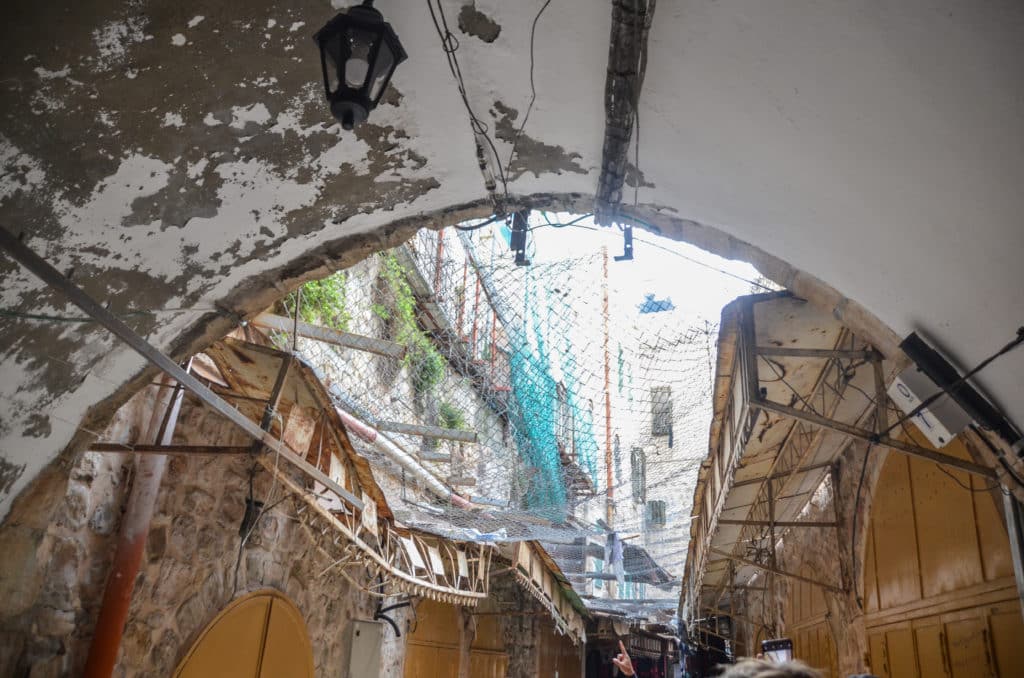
We left old town and entered the bustling more modern area of Palestinian Hebron, the streets became busier and louder. Our group garnered quite a bit of attention from the locals who were quick to call out ‘hello’ and ‘welcome’. It was a whole different world here on the Palestinian side in comparison to the empty streets we explored in the morning.
As we walked across a main square, our guide pointed upwards to a fenced off area where a number of Israeli soldiers watched. Hands on their guns as they stared down, across the fence, at the busy Palestinian streets below. A large Israeli flag fluttered on the building behind them and the whole scene looked more like an ominous warning than anything else. It was hard to believe that just a couple of hours ago these guards had been waving to us and asking us where we were from.
Is the Hebron Tour Safe?

My best response to this question is: is anywhere safe? Not really, right? There’s no guarantees anywhere.
I can truthfully tell you though that I never once felt in danger during the Hebron tour either when I was with the guide or during the time I had to explore on my own. In fact, residents on both sides of this divided city welcomed us and seemed to enjoy that we visited.
In full honesty, I did get a couple odd looks from a couple of the men while we walked around the Palestinian side on our own. I asked the guide about it after, his thoughts were it might have been because I didn’t have my hair covered. Personally, I have never covered my hair in Muslim countries/areas, however it is the norm so I do understand why that could have been the reason. Overall, however, we received lots of warm ‘welcomes’ more than anything else from both men and women alike.
PS: Be sure to check out my guide for what to wear in Israel
Final Thoughts about the Hebron Tour

The dual narrative Hebron tour was my favourite tour in Israel. Coming to Israel and Palestine, I had so many questions but the Conflict is, for obvious reasons, not something you can openly talk about. I loved that during this experience both of our guides not only answered my questions, but welcomed them as well. I didn’t feel like I needed to be too sensitive in what I was asking and I was pleased to find that neither side censored their answers as well. I learned so much during this tour and while I didn’t walk away with an answer (I don’t think anyone ever will) I did walk away with a respect and understanding for both sides.
If you read my article on things to know before travelling to Israel , you’ll remember that I mentioned a visit to Israel really should be combined with a visit to Palestine. This is the perfect opportunity to do so and learn more about the conflict from both perspectives.
Want to experience this for yourself? You can sign up for Abraham’s Dual Narrative Hebron tour here.
[…] to content I had been posting in January about my trip to the Middle East, specifically Israel, Palestine, and Jordan. If you saw these photos or read any of the blog posts, you’ll have noticed I tagged […]
[…] what to expect but I honestly believed that since I had already been to Egypt, Jordan, and even Palestine that I knew what to expect. In a way, I did. However, I underestimated the severity of […]
[…] a very strong political theme which, day after day, got really heavy. Granted, I still say that the Hebron Dual Narrative Tour was the best tour I have ever done. But, pair that with tours around the West Bank where we learned […]
[…] was wandering around Old Town Jerusalem on my own or taking part in the tour of the divided city of Hebron which has a history of tragic violence, I never once felt as if I was in […]
Leave a Comment Cancel Reply
By leaving a comment you agree with the storage and handling of your name and email address by Eat Sleep Breathe Travel. *
Dreaming of Adventure?
Sign up to the Eat Sleep Breathe Travel mail list and stay up to date with all the latest travel tips and stories.
Members save 10% or more on over 100,000 hotels worldwide when you're signed in
Hebron travel guide.
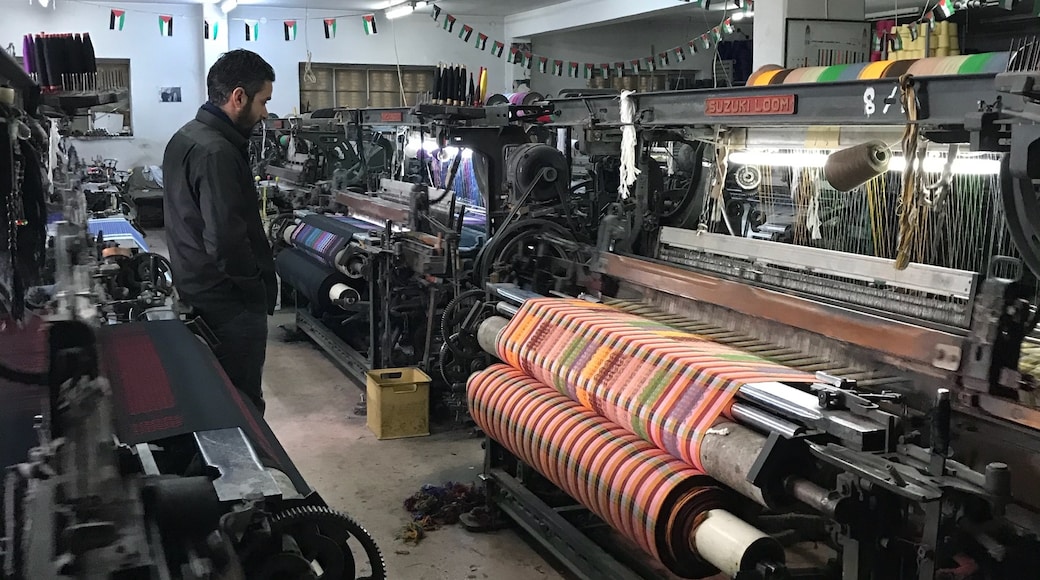
Visit Hebron
- Top hotels in Hebron
- Top Holiday Rentals in Hebron

Reviewed on 29 Aug 2023

Reviewed on 12 Mar 2018

Reviewed on 3 Jan 2023

Check Hebron hotel availability
Popular places to visit, cave of the patriarchs.
You can learn about the history of Hebron with a trip to Cave of the Patriarchs.
Russian Compound Church
You can find out about the history of Hebron when you stop by Russian Compound Church.
- Cities near Hebron
- Places of interest
- Palestinian Heritage Center
- Al-Quds University
- Manger Square
- Mosque of Omar
- Darja Canyon
Additional information about Expedia Group
Visiting Hebron: The most troubled city in Palestine
By Joan Torres 34 Comments Last updated on April 8, 2024

That moment when you realize that the Mosque and Synagogue of the Cave of the Patriarchs, one of the holiest sites for both Jews and Muslims, are separated by bulletproof glass, you realize that you are in quite a tense place but, the truth is that you are in Hebron: the most troubled city in Palestine.
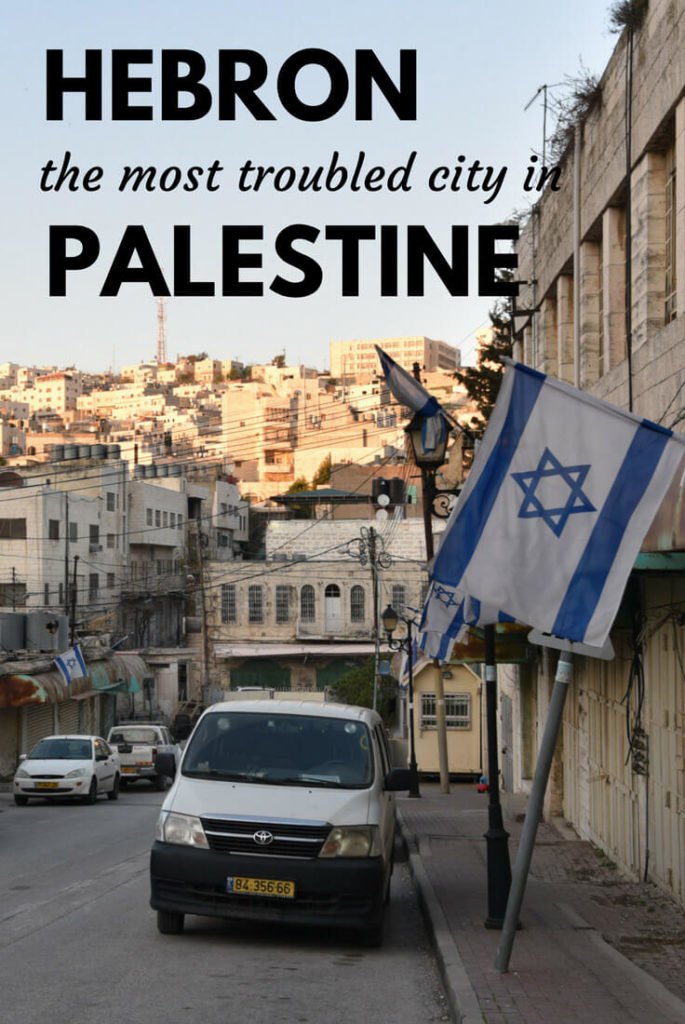
Remember that COVID travel insurance is mandatory for traveling to both Palestine & Israel I strongly recommend IATI Insurance : COVID-19 coverage + 5% discount 5% discount if purchasing via this link
This article is aimed at travelers interested in visiting Hebron, so I have tried to give an objective opinion about the conflict, based on what both Palestinians and Israeli settlers told me.
What’s my actual opinion? If you would like to discuss it further with me, please leave a comment below.
Hebron , the largest city in the West Bank, is located in the south of the region. In case you didn’t know, Palestine is divided into two regions: the West Bank and the Gaza Strip, both separated by the state of Israel.
Hebron is home to the Cave of the Patriarchs , the place where Abraham, Sarah, Isaac, Rebecca, Jacob, and Leah are buried, Abraham being the most important figure and considered a Prophet by Muslims. The Cave of the Patriarchs is the second holiest place for Jews and the fourth for Muslims.
Do you want to visit Hebron with a passionate, professional local guide, who will tell you everything about the political situation? CLICK HERE TO LEARN MORE
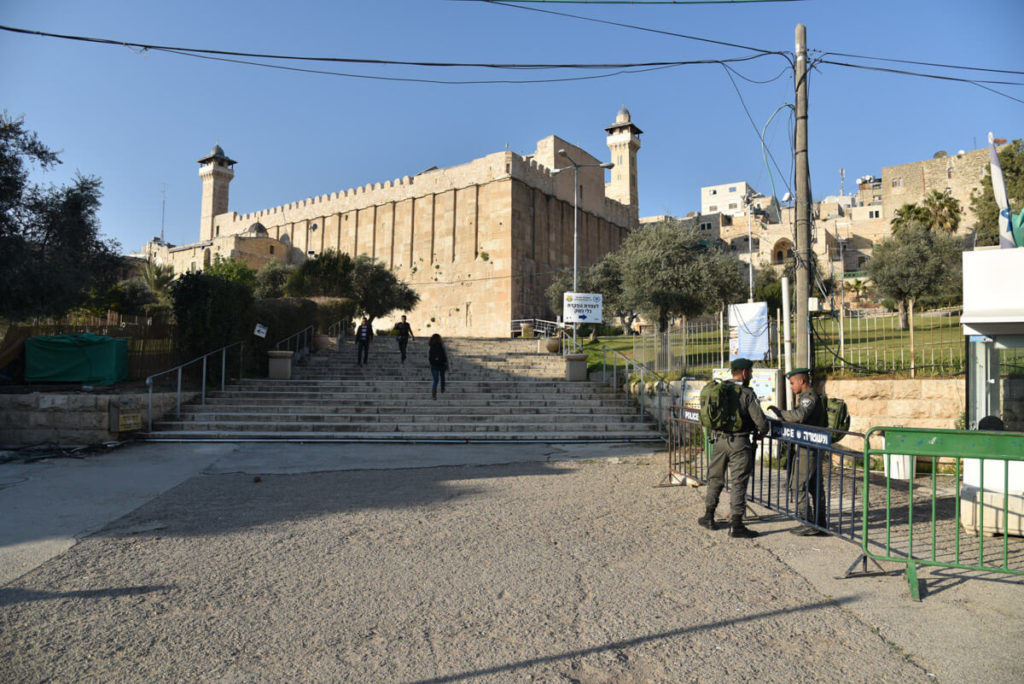
The city of Hebron has one peculiarity, which is that it is the only city in Palestine where Jewish settlements are within the city center itself. It’s quite a critical situation.
And why is that so? In order to understand it, we should look back at its history.
A piece of (very short) history
The history of Hebron is complicated but, summarizing, Jews have been present in this city from Biblical times, and Muslims have also lived there for many centuries.
In the middle of the 19th century, there were just a few Jewish communities and Hebron was deeply Islamic, with a tradition of hostility to Jews.
Due to Zionism, the number of Jewish people kept increasing, however, in 1929, the Arabs committed a massacre, killing around seventy Jews.
The survivors were forced to leave Hebron.
In 1967, after the 6 Days War , Hebron came under Israeli control. From then, given its strong religious symbolism, the Israeli Government started to build settlements within the Old City itself.
Read: The art of the Palestine – Visiting the kuffiyah factory in Hebron
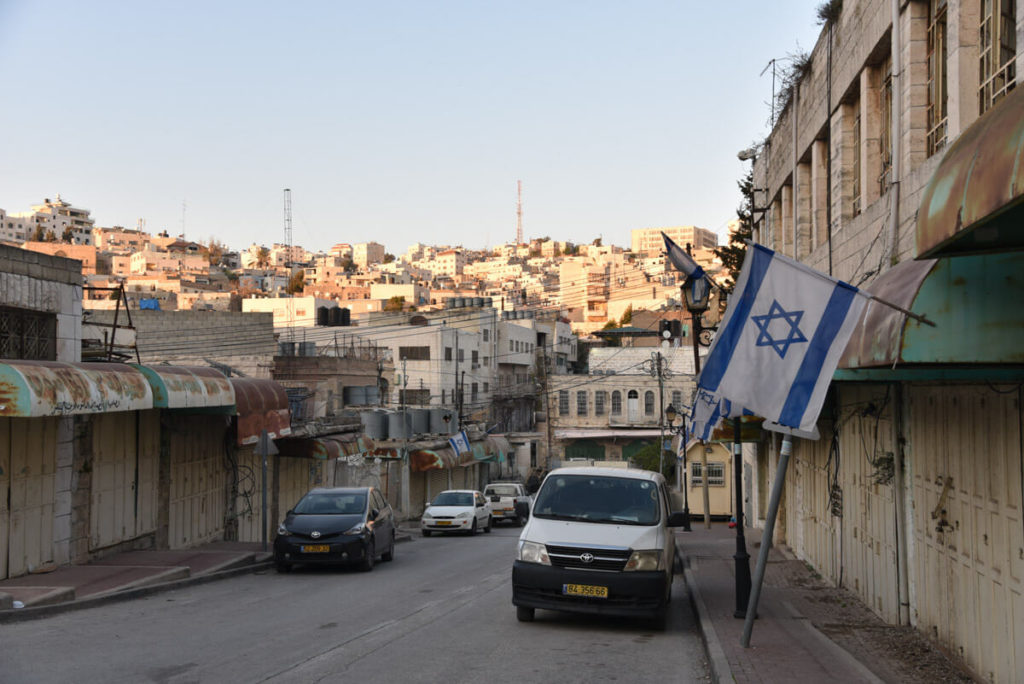
Visiting Hebron: The situation nowadays
Israel has been building settlements for more than 50 years, to the extent that, today, the city is completely divided. H1 is the area controlled by the Palestinians (80%) and H2 is the area controlled by the Israelis (20%).
If you own a passport which doesn’t belong to a Muslim country, it’s possible to visit both sides. Otherwise, it won’t be possible for you to visit the settlements and synagogue.
The full itinerary takes 5 or 6 hours approximately, going slowly and including a lunch break and visiting the Cave of patriarchs (from both sides).
H1 – The Palestinian side
In the old city of Hebron, what used to be a busy market, full of joy and happiness, is today nothing but a semi-abandoned area, whose inhabitants can’t avoid expressing their hatred of the settlers, every time they meet a foreigner.
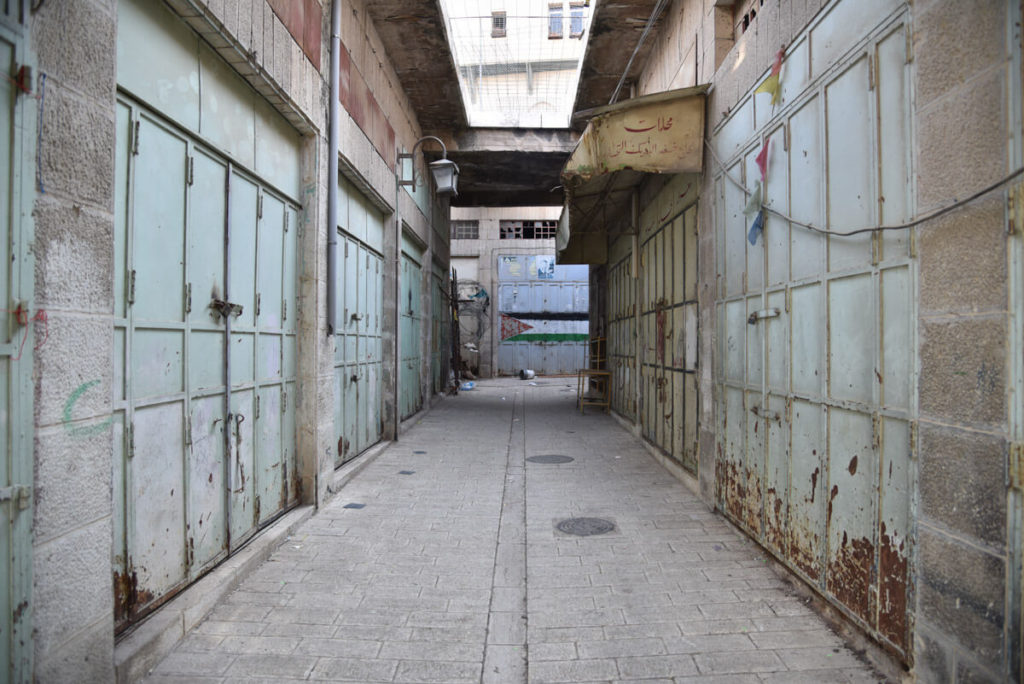
Most of the Old City is covered by a metal fence, to protect the street and the people from settlers throwing garbage at them, from their houses. After the fence was built, the settlers started throwing bleach, eggs, and excrements as well.
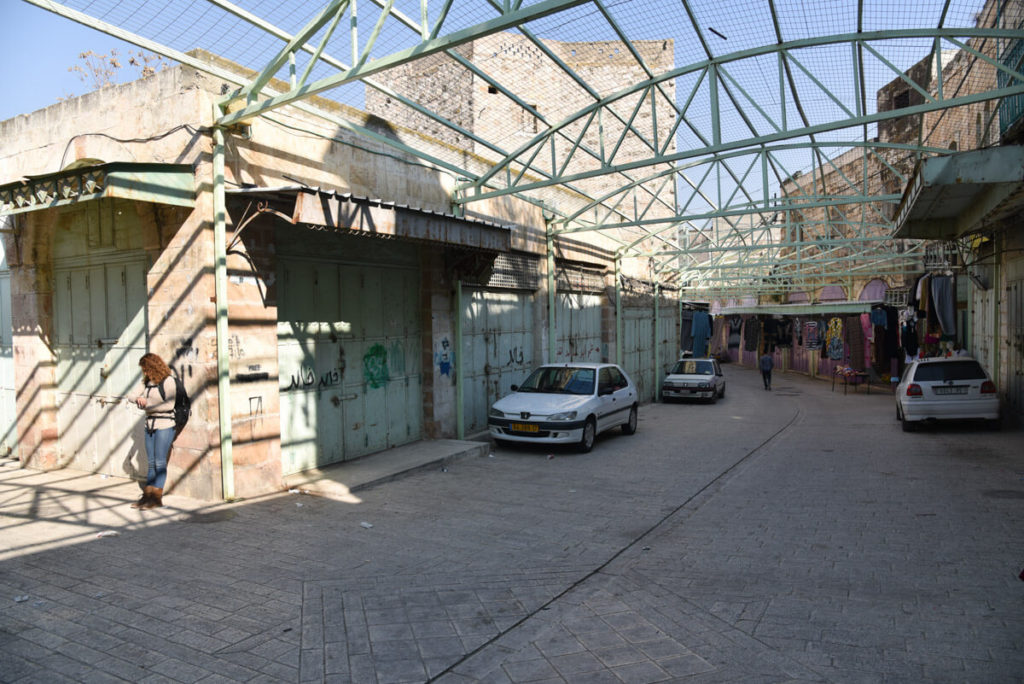
The Arab buildings situated in front of the Jewish buildings are also a target for the settlers and, for this reason, their balconies and windows are protected with strong metal bars.
Some Palestinians claim that, occasionally, the settlers have even thrown Molotov cocktails at them.

The Israeli Army doesn’t do anything to prevent this sort of violence from the settlers. However, they have the right to shoot at any Palestinian who attempts violence against any settler, even if it’s in self-defense.
Many streets in the Old City were just abandoned, and business and shops were closed, either because they were afraid of the settlers or because the Israeli authorities blocked them, for security reasons.
Read: Lebanon 15-day itinerary
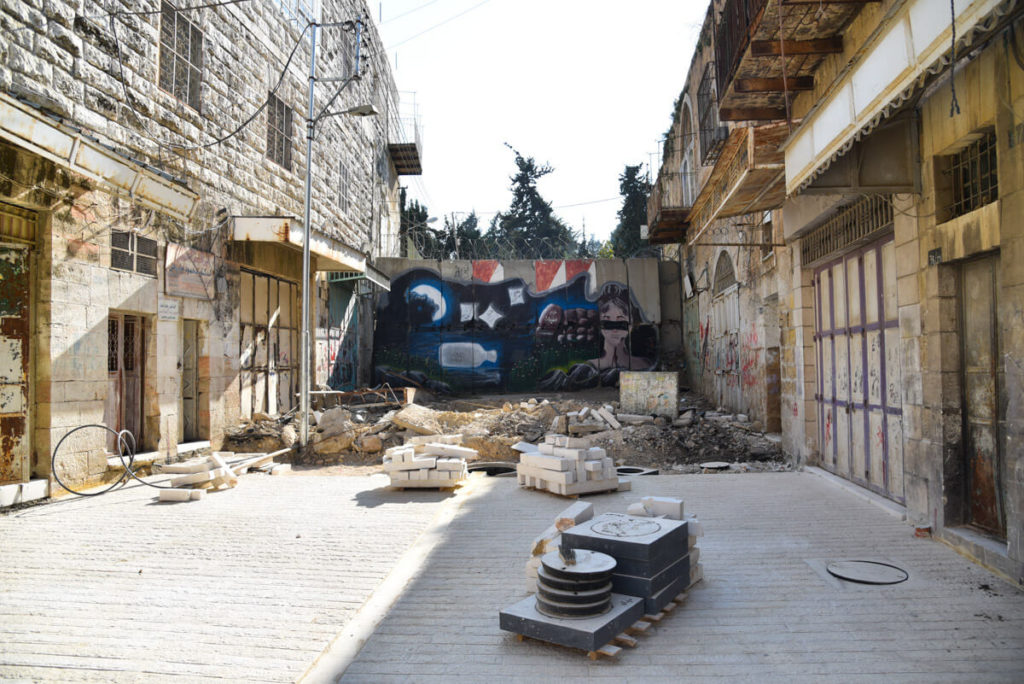
Abraham’s tomb – Neutral zone
After the H1 itinerary, you find a checkpoint to access Abraham’s tomb.
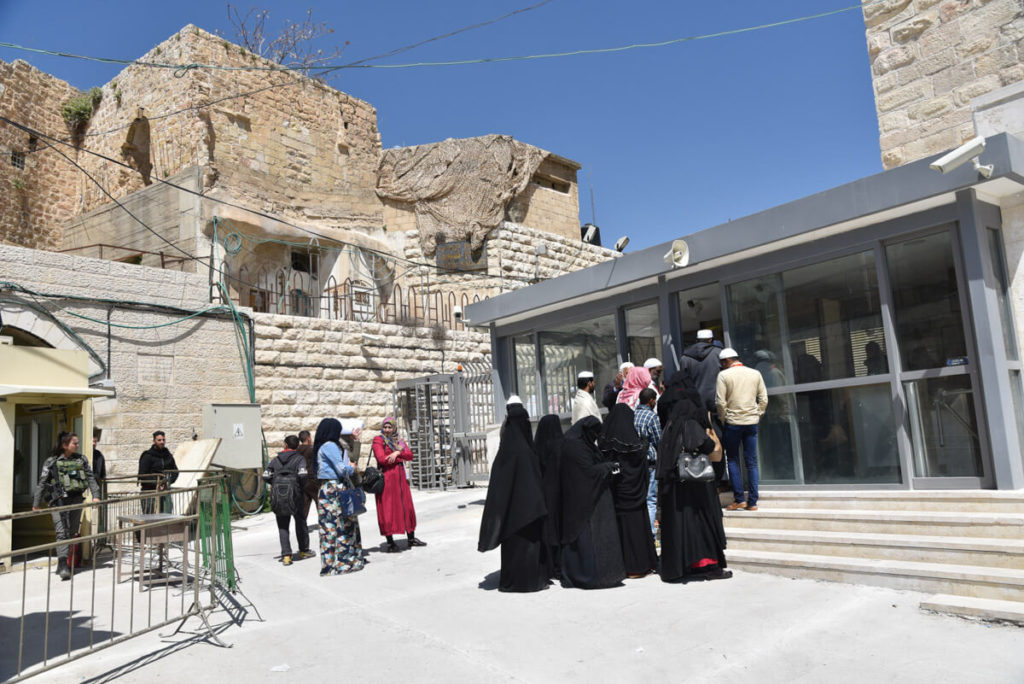
Abraham’s tomb is literally located between the synagogue and the mosque, so it’s visible from both sites. However, in 1994, an American Jewish entered the mosque and opened fire, killing 24 Palestinians, during prayer time on a Friday in Ramadan.
It was a real act of cruelty that moved the entire world. Since then, the security checkpoints have become just insane and Jews can’t enter the mosque and Muslims can’t enter the synagogue.
Abraham’s Tomb, which is the area shared by both religions, is separated by a bulletproof window. This place is just crazy.

H2 – The Jewish side
The Jewish side is of less interest than the Palestinian for the simple reason that it’s just a residential area. The streets, which used to be busy, have become mere transit roads for the military.
On these streets, there are still a few Arab families living. To protest against that, some Jews painted the star of David on each one of their doors.
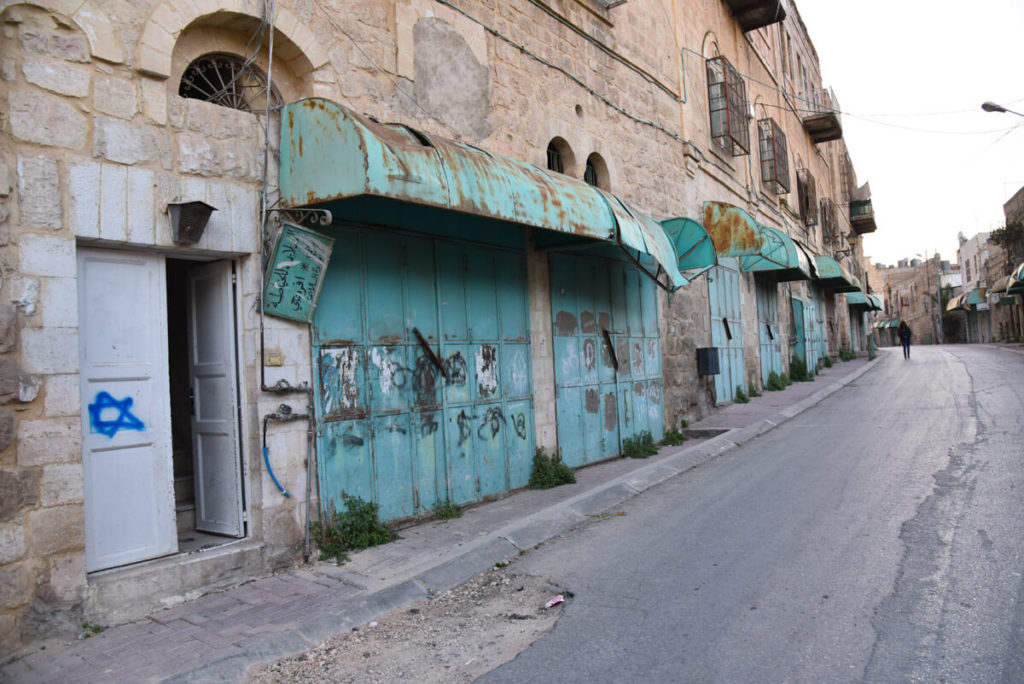
If you wish to have a broad and generic opinion about the conflict in Hebron, I suggest you talk to any settler living there and let them tell you their side of the story.
Since they’ve received a lot of international criticism, many of them will be happy to share their version with you.
Basically, they will talk to you about the 1929 massacre, when Arabs killed over 60 Jews. The Jews have inhabited Hebron since Biblical times and Abraham’s tomb is one of the holiest places for their religion.
They have the right to live in Hebron and banning them from living there would be the equivalent of banning Muslims from visiting or living in Mecca.
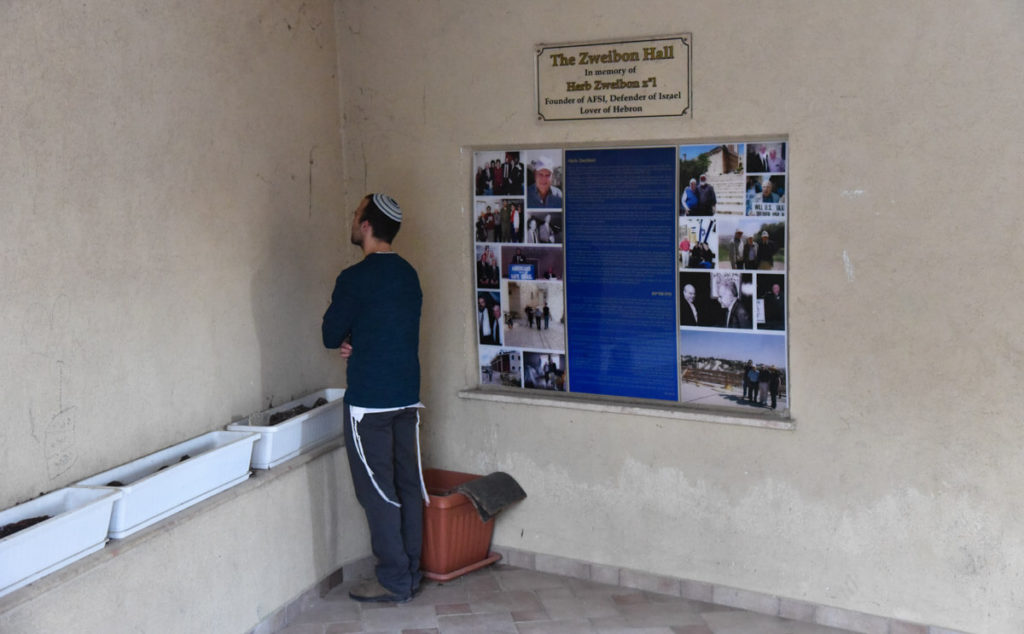
They also say that the Israeli Government and Jewish Institutions in New York are offering 20 million USD to every Palestinian family who leaves their house in the Old City.
However, the Palestinians refuse it for two reasons: Firstly, they claim that, according to the Quran, if they accepted, they would go straight to hell for helping the enemy. Secondly, because if they did, they would have to leave the country because all Palestinians would exclude them from their society.
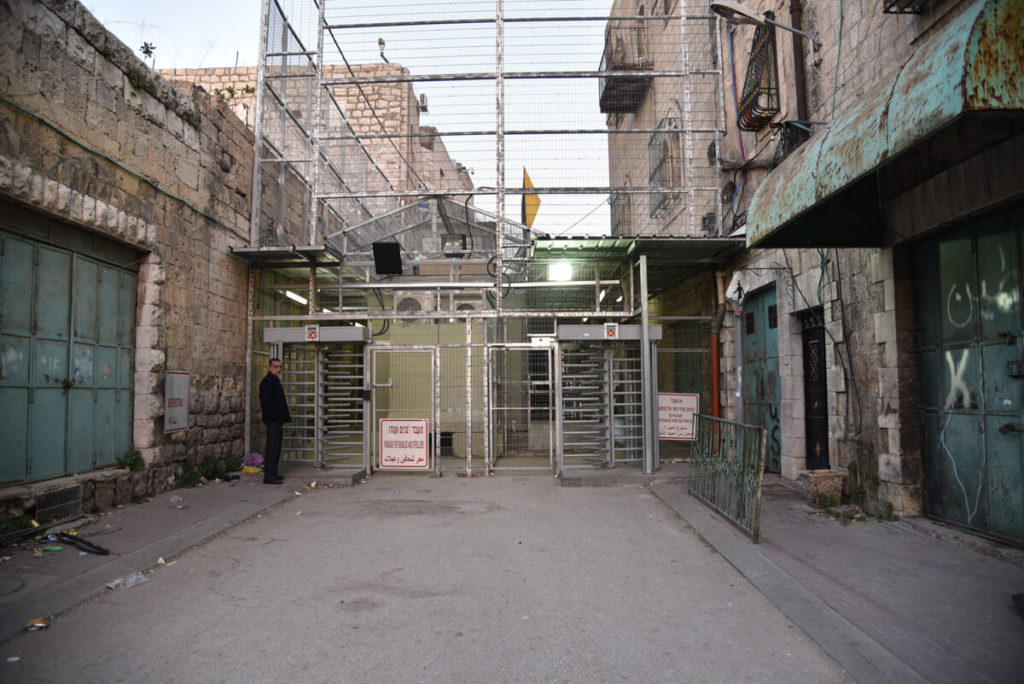
What’s the actual truth?
Like a good Palestinian friend of mine once told me, the reality is so complex that we will never be able to know the real truth.
More information about visiting Hebron
📢 In my Travel Resources Page you can find the list of all the sites and services I use to book hotels, tours, travel insurance and more.
Don’t forget your passport!
Tours – GetYourGuide offers tours which can be booked with just one click and always count with professional local guides. Their Hebron tour is run by a very passionate local dude.
How to get in – There are direct buses from several big cities, including Jerusalem (16ISL – 8$), Bethlehem (8ISL – 4$) and Ramallah.
Is it safe to visit? – Yes. Violence is occasional and it would never target foreigners. Besides, the weapons used are bleach and excrements rather than bullets.
Is it possible to visit Hebron on a day trip? – Yes. It’s possible to visit Hebron on a day trip if your intention is to just do the main itinerary. However, Hebron has many interesting sites, such as the Palestinian Kafiyya factory, Abraham’s monastery or enjoying the multiple restaurants serving traditional Palestinian food. Visiting these places would require additional time.
Where to eat – Around the Old City, you’ll just find Arab fast food. The area containing all the restaurants serving traditional food is far away from the city center. These are the coordinates: 31.5550231,35.0997087 . However, unless you spend the night in Hebron, you won’t have time to go there.
Where to stay in Hebron
Backpacker’s Hostel – Friends Hostel.Area B – Located in the center of Hebron city, this property has a separate dormitory rooms for male and female and 1 private room.
NGO Hostel – Lamar Hostel – This hostel is owned by the Hebron Rehabilitation Committee (HRC), an organization which aims at providing with decent housing to Palestinians living in the Old City. If you stay here, you will help to improve the life of the many Palestinians suffering in Hebron.
Couchsurfing at Mo’s – Mo is a Palestinian who has hosted over hundreds of people in Hebron. He was more than happy to be included in my guide Meeting Mo was one of the highlights of my trip!
Don’t forget to check our travel guide to Palestine .
As well as all our Palestine articles:
- A City Guide to Gaza
- A Guide to Kuffiya Factory in Hebron
- Palestinian Refugee Camp in Bethlehem
- Things to know about Palestine
Si te gusta mi blog y encontraste el artículo útil, que sepas que si comprases cualquier servicio a través de cualquiera de mis links, me llevaría una pequeña comisión sin que a ti te suponga un coste adicional. Dichas ganancias son las que me ayudan a mantener este blog con vida.
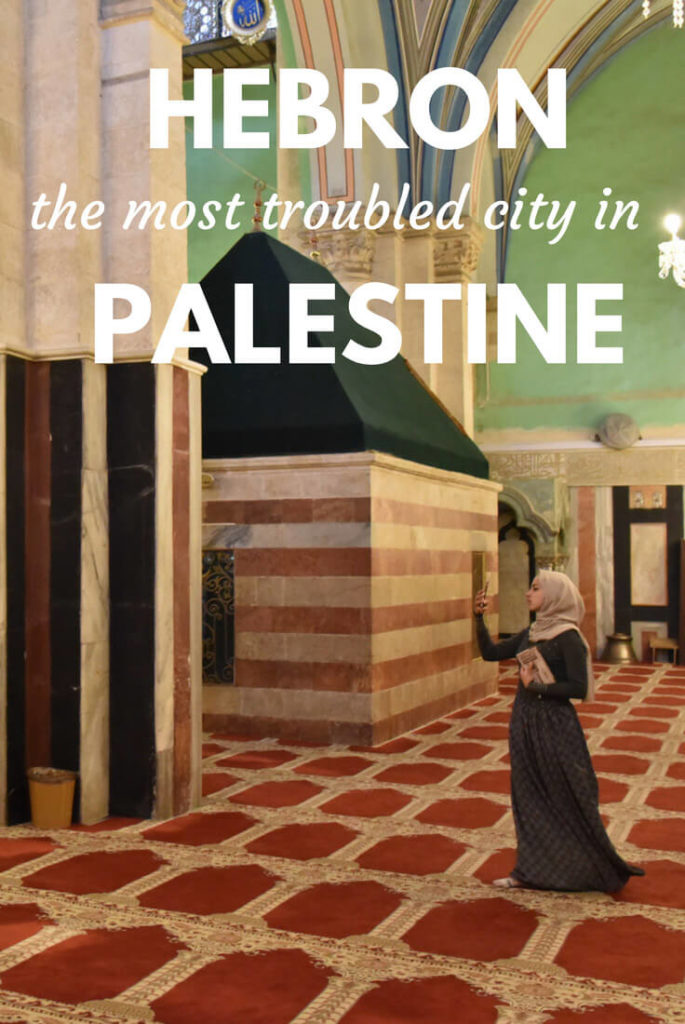
34 comments
Very interesting post, and I appreciate that you covered the troubled past that has led to the troubled present. I have a Jewish friend whose family had lived in Hebron for centuries and was subsequently forced out, so I think the reality is not nearly as black and white as some on the Palestinian side would present.
Hi Melissa, thanks for sharing your opinion 🙂 I’m sure your friend’s family must have very interesting stories to tell.
I tried to cover what happened in the past but, as I said, this is a very small summary. Their history is too complicated. We can’t say that the 1929 massacre was the cause of the conflict, as this fight has been happening for centuries. Also, this 1929 massacre could have been partly caused by the Zionism, a movement which I don’t believe in. There are too many causes and consequences. We’ll never find the truth but, if there is something I am sure about, is that for the last 5 or 6 decades, the Israeli government is not acting correctly.
I read this article for some information and was very disappointed at the bias displayed here. You call people Jewish incorrectly, such as the Jewish is standing and praying. It is actually the Jewish man or Jewish woman, not just a Jewish. Secondly, you attempt to justify the murders of Jews in 1929 due to “zionism” which means simply Jews believing they can live in Israel which is their Holy land. Yet, you discuss as “cruel” the murder of Arabs praying in a mosque. So according to you, Jews deserve to be murdered for simply living in a place, but the murder of anyone else is “cruel”. While settlers may throw garbage onto the street as pictured here, or even commit other unacceptable acts (I only have your words here to go on as you haven’t offered proof of excrement or bleach thrown), you completely gloss over and leave out the reason why there is a military presence in the area which is the constant and violent attempts by Arabs in the area to murder Jews. You say that you are neutral, but then admit in the comments that you are anti-zionist. So essentially, you don’t believe that Jews should be allowed to live in a place where their holiest sites are, in peace, and you ignore the fact that the only reason there are checkpoints is to protect those Jews from being murdered. Yet you point to the jewish star of David stamped on Arab doors as a great crime, while hiding the crimes against those Jews. I am not one to defend the bad behavior of Jewish settler’s, but you have no excuse to hide the truth of how violent and intolerant the Muslim Arab population is towards the Jews in Hebron.
You are putting some of my words out of context but anyways, if you want me to say it… Yes, I don’t believe in Zionism and I don’t like Hamas either. I don’t like any extremism and I think that those settlers are crazy fucks. Moving to such a troubled place, forcing many Palestinians to go away from their homes, just because it is their holy place, just because a deal they made with god centuries and centuries ago, and all happening in the 21st century… This is totally bullshit man and maaaaaany Israelis know that… Murdered for simply living in a place? Please, don’t make me laugh… The Palestinians may have done many things wrong but dude… what the settlers are doing has no name. Internationally, the settlers policy is only supported by Donald Trump, so that says everything…
Why the foul language?
“Yes, I don’t believe in Zionism ”
So you dont believe in the right for jews to have their own country in their homeland? But you have no problems, what so ever, with there being over 40 moslem states/countries… Hebron, hebrew. Jews/Jood/Jude -, Judea.
Arabs cant even say P so how can “palestine” be theirs? Filastiiiin filastiiin… Well, if theyre “filistines” they should go back to Crete or stay in Gaza.
“Internationally, the settlers policy is only supported by Donald Trump, so that says everything…”
Maybe you should educate yourself and listen to what other national leaders say about this.. I.e the President of Czech Republic for instance.
And isnt it hilarious that the moslems claim every God damned place to be “holy” to them? How many are they going to have? And you show your lack of knowledge by saying its “islams 4th holiest place”. What a load of BS. Especially since the Shias and Sunnis have different opinions on this. Two towns in Iraq are more “holy” to moslems than Hebron, which puts it at #6… Hell, PETRA is even more holy to some moslems than Hebron. They have their Meccas and Medinas, Jews have Yerushalaem and Hebron. With moslem logic the jews should probably claim Jericho as well.
Your attacking the jews for the same reason your supporting the arabs moslems. They say that their “prophet” claims this and that, and youre okay with that. But when the jews say it, its “a deal with god centuries ago” and it doesnt count.
What about jews living in Mecca today? (ironic, right?) – for how many seconds would their house stand before someone sets it on fire and kills them?
Joan, you are disappointing me. I don’t like extremism too, as you put yourself, however:
1. Zionism is the national movement of the Jewish people for self determination. If you don’t believe in Zionism, you are putting yourself in the side of those whom oppose the the Jewish right of self determination, while you are supporting the Palestinian right of self determination. Why only the Jews are not “worthy” enough for self determination? Are you really against extremism? if you are, you should respect the Jewish right of self determination.
2. Settlers – the settlers are not a homogeneous group. Calling them as a group ‘crazy fucks’, apart from the extremely INAPPROPRIATE foul language, shows that your views are ‘black and white’. Everybody knows that the world is grey (except for extremists). If you are not an extremist, I think you shouldn’t use foul language at all for once, and I would expect you, a person whom have traveled in the West Bank, to know that the Israelis that live in the West Bank are coming from very, very, wide backgrounds, beliefs and political views. Thus, not calling them as a group in any adjective. Thinking that ALL settlers are there because of a deal with god is part of the problem, of not understanding the wide Israeli society.
3. “murdered for simply living in a place?” – are you really blaming the Israelis for murdering Palestinians for a place? I am in awe. Are there rogue Israelis? yes. Are there rouge Spanish people? yes. Does it say that all the Israelis or all the Spanish people are bad? NO. I am not justifying actions done by individual settlers, whom consist a very small minority of all of them. They should be persecuted by the law, and many are – as Israel is a lawful country. If you believe that Israelis are murdering Palestinians as a matter of state policy, you are being brainwashed. Joan, I thought you are smarter than that.
Hebron is the oldest Jewish city in the world. The fact that “Palestinians” (Arabs from Arabia) now live there is of note but the true history of the place can’t be ignored. Additionally, ths article shows a “fence” above a market place. But the comment about it doesn’t make any sense. Written in the article is that the settlers throw eggs (etc.) down from there so the fence stops that. Frankly, I have no idea how what is show would stop anything. Anyway, then the article goes on to say that AFTER the fence was constructed, then the settlers starting throwing eggs, etc. So what is it? Before or after? It is difficult to take seriously an article that is written so badly and contradicts itself, although always framing Jews as culprits.
What you’ve written under the title “A piece of (very short) history” is very biased!
My comments: The Jewish presence in Hebron goes back for centuries, before Arabs came to to city. The Jewish community there was actually not Zionist. They even rejected the proposal from Zionist Jews to have armed Jewish guards (as they were in other Jewish communities in the country) since they believed centuries of co-existence with their Muslim neighbors will do their job. But, that didn’t work, and as you mentioned – there was a massacre in 1929, after which the Jews were forced to leave their homes in Hebron. As an ancient community in the city, the homes of the Jewish community are located in the old city of Hebron, naturally.
Since 1967, Jews returned to Hebron and settled back in the JEWISH PROPERTY left behind in 1929, the same Jewish homes in the old city of Hebron.
Thanks for adding the comment. It’s difficult to summarize everything in 2 sentences but, at least, I tried to mention the 2 massacre from both sides, to keep the article objective. I have approved your comment so people can read it. thanks
You did make some attempt to be objective. I appreciate that.
Hi Joan, I loved this article! There are always two sides to a story, and in the case of Palestine and Israel, you can’t win. If you offer a thought, you will get blasted from one side or the other. This article is about unbiased as you can be without picking a side. I admire that you held your own on these comments. I write a blog as well, and I defend my thoughts when people want to debate my experience or tell me how it is according to them. What baffles me is how many people will jump in with their opinions. Most have not experienced it for themselves. Mainly people from the west who live off of the politically driven version of news vs. reality. I can say this with clarity – I live in the US! I did a tour in Belfast where we explored the area’s where the Troubles occurred. I’ve not written about it yet. But, whenever I tell people about it, they have no clue what I am talking about. Add insult to injury they can’t comprehend the reality of walls diving communities over religion. And that’s in Belfast At the end of the day if people don’t like what you offer they should move on. Cudo’s for being brave enough to share your experience. Great article! Nikki – Brit on the Move
Hello, how are you?
Is it possible do visit Hebrom without a guide? The bus station is near the Complex and the Souq? I mean, can i do walking?
Yes, it possible. The bus leaves you between 1-2km from the old city
Thank you for the quick reply.
So, the same place where i will be dropped i get the bus back to Jerusalem or Bethelem? From that place is easy to find the souk?
The souq can be easily found, yes. You just need to go straight, down the avenue. Do you have maps.me? That place where I dropped off isn’t really a station but if you go back, you should find one going to Bethlehem on the same street. Worst case scenario, you can ask about Bethlehem Service. They will understand what you mean.
Nice, thank you again.
Until now i don’t know if i’m going to stay the night in Bethelem or Jerusalem.
I’m so glad to find this as I am about to post about my experience on the Dual Hebron tour on my blog. Would it be okay if I used your picture of Abraham’s tomb? It came out better than mine. I’d be glad to give you photo cred and I’d like to link this post to mine at elizabethbbristol.com for readers who are interested in more perspective if that’s okay with you? Thanks!!
Your objection to Zionism, as extremist, means you do not believe the Jewish people deserve a state in the homeland in which they have resided for 3,000 years, no matter how minuscule. It might be helpful to your readers to understand your reasoning.
Coming back to the Holy Land land, mainly because a deal you made with God 3000 years ago is totally bullshit, and colonialist, and racist, not to mention the expulsion of the Palestinians from the land they had been living for generations. Zionism’s plan was not to take a minuscule land as you say, but it was a movement that lead to actual violence and truly promoted land confiscation.
I’ll always be against any form of antisemitism, but Zionism is bullshit.
Please learn about the 850,000 Jewish families who, in the 1930s, were forced to flee with only the shirt on their back and all their properties confiscated, from Arab nations: Lebanon, Syria, Iraq, Egypt, Morocco, Algiers, Tunisia, Libya, Iran. These precious people had nowhere else to go. How would YOU like to have NO PLACE in the world where you could lay your head down to sleep and feel safe? ———————– Current research documents that the number of Jews living in Arab countries and Iran totaled more than 850,000 at the time of Israel’s independence. Some scholars even think the number is closer to one million. In the North African region, 259,000 Jews fled from Morocco, 140,000 from Algeria, 100,000 from Tunisia, 75,000 from Egypt, and another 38,000 from Libya. In the Middle East, 135,000 Jews were exiled from Iraq, 55,000 from Yemen, 34,000 from Turkey, 20,000 from Lebanon and 18,000 from Syria. Iran forced out 25,000 Jews.
1. “Coming back to the Holy Land”: 1a. You are ignoring the fact that there were always Jews in the Holy Land. 1b. Yes, the Jews came back, not because of a deal with god. Zionism, The Jewish movement for self determination, is – believe it or not – secular, always was. I hope one of your eyebrows moves up (otherwise you have been brainwashed too much I would say). The fact that there was a Jewish Kingdom in the Holy Land for over 1000 years is indisputable (and I’m not talking about beliefs). Since it has been conquered by the Romans in 70 C.E (whom have relocated many Jews to Europe as a punishment), there was never any other independent country in the region. It took the Jews 2000 years but they are still here today, and they have a right of self determination. No, not on the expense of the Palestinians. But a right of self determination, just like any other nation has. The Palestinians bear a right of self determination too. And them too, not on the expense of the Jews. The Israelis and Palestinians will have to find the middle way here. The Israeli-Palestinian conflict is not a Jewish-Muslim conflict. Jewish or Muslim values are not attacked in the crisis. I am sure you have mentioned that, and thus I hope you realize that those whom try to take it to the religious level are the extremists.
If you have access to history books, try to get a book on the 19th century, to see how small the population was in the country, almost an empty land. I cannot accept any attack on the Jewish right of self determination that globally says that the Jewish right is bullshit, colonialist or racist. Either be precise, talk about specific cases, or do not talk like this. Please, this is not the way civilized people talk.
Hi Joan, I visited Hebron last year, as a “born-Christian, now aethiest” European. I think you have presented a very fair and reasonable explanation of the conflict and tensions in Hebron. I found the settler’s conduct appalling, and I was disgusted by how they treat the Arab families still living in H2. There were even 2 Jewish men in our group and they were shocked by the situation. There was an Arab shopkeeper close to the synagogue, who was a very nice man, and his family too, and we saw first-hand how badly he was treated by not only the settlers passing, but also the Israeli army in their checkpoint hut opposite his house.
To be anti-Zionist is a form of being antisemtic, and your article and the comments that follow scream it. I don’t agree with violence of any kind, and this article only briefly mentions a massacre against Jews in 1929 (this was 20 years before the state of Israel was established, the residents were not Zionists), and then goes on to a laundry list of transgressions by Jews against Palestinians. Without degrading the very real and upsetting Palestinian experience, if you had spent any time speaking to the Jewish population with an open mind, you would have heard that there have been–and continue to be–two sides to this story. Among your most shocking omissions (of which there are many), you forget to include that in 2001 that a Palestinian sniper aimed, shot, and killed a Jewish BABY (Shalhevet Pass) solely because her father was dressed as a religious Jew. Did you just “forget” the Israeli government’s large, bright red signs that dot the road as you approach Hebron and warn Jews to only enter the city at their own peril? Suffice to say there is a reason that the IDF has a strong presence in Hebron, and to use your own crass words–it’s not just to back up the bad acts of some “crazy f*ck” settlers.
I’m really shocked by this biased and one-sided article. You did not even mention in a hint the hundreds of Jews who were murdered and injured in recent years solely because of their sin that they were born Jews !! I have no explanation for the fact that you completely ignore the Jewish side. Indeed, the indecent anti-Semitism against the Jews and their accusation of persecution against them has always been, and unfortunately I see that even today it exists and in a big way.
I think the focus of this thread is a bit off: Jews have lived in Hebron for centuries, but that doesn’t justify the human rights violations that the state of Israel & the settlement movement is currently perpetrating there.
The issue in Hebron is a case of national sovereignty being violated: the city of Hebron is a Palestinian city (like Tel Aviv is an Israeli city), and the Israeli settlement movement, supported by military protection from the IDF & the government, is building settlements in that city that they claim are an extension of the Israeli state into that city. This is not a question of Jews moving into a Palestinian city, but one of Jews creating a piece of Israel inside Hebron where they abide by Israeli laws that allow them to attack Palestinians. The settlers are homogenous in that they are homogeneously violating international law in building their settlements. If someone moved into your neighborhood and placed their country’s flag there and said that your neighborhood is now a part of their country, wouldn’t you be angry & intolerant? This isn’t a question of Jews & Arabs peacefully coexisting, this is a question of settlements seeking to take over pieces of that city in the name of Israel. And its not just in Hebron, but all over the OPT.
If anyone is interested in learning more about Hebron and the nuances between “Jews living there” v. the settlement movement, please check out this short documentary by a former IDF soldier: https://www.nytimes.com/2021/11/16/opinion/israel-palestine-idf-mission-hebron.html
If you’d like to learn more about martial law and brutal occupation policies Israel has inflicted on the Occupied Palestinian Territories as a whole, check out this resource by activist & Oscar-nominee Farah Nabulsi: https://www.oceansofinjustice.com/
As a half-Jew, it is important to me that Jews have a homeland. The fact is that they do have a homeland now. It’s against Jewish values (and international law) to try to expand that homeland further by displacing people who have lived in the area for over a millennium. While the violence of the past breaks my heart, it’s also true that the violence was two-sided (e.g., the Palestine Riots mentioned above saw an equivalent number of Arab deaths overall compared with Jewish deaths). If you’d like to learn about the Palestinian side of the story since 1948, please google: “Nakba”, “Deir Yassin Massacre” and “al-Dawayima Massacre.”
A former IDF soldier can also lie, or to be more precise, a half-truth is worse than a lie.. And regarding the “crimes of the settlers”, Israel is a state of law and all security measures are legitimate things to prevent the murder of Jews for a purely racial motive as happened in the past and is happening these days Israel has done the nonsense you are preaching in the past, and unilaterally seceded from the Gaza Strip and expelled 8,000 Jews from there, and what did we get??? Missiles and rockets and abysmal hatred and taking all the billions the world poured there into weapons and extreme Islamic terrorism, so you expect us to double the state of terror/Hamstan times 20 in the West Bank, which controls from above all of Tel Aviv and the airport and the entire center of the country???? Is there a single country in the world that you would demand with such wickedness and brazenness to commit such an act of suicide?! Finally, I remind you that the so-called “moderate” Palestinian Authority calls squares and streets over It names murderers and calls them “heroes”, and also gives high salaries to murderers in prison whose salary amount is determined by the number of years they were sentenced to.. In other words, the more Jews you kill, the more money you get… Shame that you defend these anti-Semites instead of defending the only democratic and enlightened country In the Middle East in the sea of darkness and the dictatorships in the region.. as long as the plastic Nim will not educate their children for peace and tolerance and not for terrorism and violence, and stop ruling over them with extremist and homophobic people, there will be no peace here!! After everything the Jewish people have been through for thousands of years, we will defend ourselves on our own!!
Pretty Islamaphobic sir: Lebanon, Tunisia, and Turkey are all democracies and though its a monarchy, people have a pretty free life in Jordan as well (I’ve visited). Israel is democracy for Ashkenazi Jews (myself included), but Arabs, Christians, and even black & brown Jews are all treated as second class citizens, or worse (I’ve lived there, I’ve seen).
And then to call all the people of Gaza “terrorists” — where is your humanity? Do you know that 47 people died last weekend, of which 15 were children? Do you know that Israel has a policy of controlling how much food goes into Gaza so the people there, mostly civilians, are kept at just above starvation level? Do you know that over the past 10 years, 1100+ children have been killed in bombings in Gaza…And why are they in this battle? Because 1M+ of them were displaced from their homes of 1000+ years in 1948, moved into 2 tiny territories, and increasingly infringed upon by settlements, and not allowed to leave or else they will never be allowed to return. And yes, given all that, they fight back against the IDF’s tanks, sophisticated weaponry, and US funded Iron Dome. The Palestinians did not have anything to do with the Holocaust or the pogroms or the Romans – don’t conflate these things. And to your point, Jews who murder Arabs also get high salaries & power — look at Ariel Sharon, who went from the Sabra & Shatilla massacres to the Prime Ministry! And Menahem Begin, who ordered the massacres as Prime Minister!
This is a war with 2-sides, and the numbers of casualties (especially among civilians and children) on the Palestinian side are really mind numbing. Everyday on the West Bank, a child is killed.
Re: Hebron & the OPT: The issue, again, is not Jews coexisting in Palestinian territories. It’s the fact that settlers who settle there claim the territory as “sovereign Israeli land” which it is NOT according to international law. As documented by Human Rights Watch, Amnesty, and B’Tselem, the settlers perpetrate tremendous violence against the rightful Palestinian residents in an effort to get them to leave: https://www.hrw.org/report/2021/04/27/threshold-crossed/israeli-authorities-and-crimes-apartheid-and-persecution . But where can they go? This is their home too for the past 1000+ years, and if they leave, they will never be allowed to come back.
I guess you can always say everything is a lie & fake news – that’s the nature of the world in 2022. But the New York Times, the Oscars, the UN, HRW & Amnesty – if these are lies, then there isn’t any truth left in the world.
Thanks for the great story Joan!
What a great blog article Joan. Nuanced and objective. Having been to Hebron, I was horrified by the vigilantes that pose as settlers and wreak havoc and horror for the average Palestinian on a daily basis. I support the right of Israel to exist but find it very difficult to justify what is being done in Hebron by Israeli settlers, while IDF soldiers look on and do nothing.
Thanks for the comment, Omar, agree 100% 🙂
Is it still safe to visit Hebron at this time? Also, are American citizens allowed to go to the Gaza Strip. I am a Filipino American here in Los Angeles.
Hi Michael, nobody has ever allowed entering into Gaza unless you are a journalist or a humanitarian worker, and Israel is he one ho has to approve it. Good luck.
Hi Joan, thank you so much for this information. I live in Los Angeles and have never been out of the country. I want very much to visit Hebron and see what life is like in the West Bank. Joan, do you think I can visit here for a few days on my own? What I mean is without a tour guide. Just by myself. Or do you think it would be too difficult and dangerous for me with no travel experience outside of the US? Your advice would be greatly appreciated. Thank you.
Hi Mike, Hebron has always had many foreign visitors and tourists, you won’t have a problem there. If you don’t feel confident, you can book a tour in your hostel in Jerusalem
Leave a Comment Cancel reply
Your email address will not be published. Required fields are marked *
Notify me when new comments are added.
Join our Expeditions
From Syria to Iraq in Pakistan, Against the Compass is finally running expeditions to the most epic and off-the-beaten-track countries.
We have scheduled expeditions for every month of the year.
Latest posts
- How to Travel to Libya in 2024
- Backpacking Venezuela Travel Guide (2024)
- How to travel to Afghanistan during Taliban rule (2024)
- How to visit Los Llanos in Venezuela
- How to visit Angel Falls and Canaima National Park
Explore Hebron
- It is currently recommended to avoid all non-essential travel to this area.
Plan Your Trip to Hebron: Best of Hebron Tourism

Watch The Wanderer
Essential hebron.

- Abu Mazen Hotel
- Friends Hostel Area B
- Lamar Hostel
- H2 Hostel Hebron
- Regency Hotel Hebron
- 21 Café Hebron
- Juice Corner
- Coffee Corner
- Fatima's Workshop
- Cave of the Patriarchs
- Hebron Glass & Ceramics
- Susya - National Heritage Site
- Masjid-E-Khalil Mosque
- Mosque of Prophet Yunus

Navigate forward to interact with the calendar and select a date. Press the question mark key to get the keyboard shortcuts for changing dates.
Navigate backward to interact with the calendar and select a date. Press the question mark key to get the keyboard shortcuts for changing dates.
Hebron on your mind?

Top places to visit
Ibrahimi mosque, what's the weather like in hebron.
It depends on when you visit! We've compiled data from NASA on what the weather is like in Hebron for each month of the year: see the links below for more information.
- Weather in Hebron in January
- Weather in Hebron in February
- Weather in Hebron in March
- Weather in Hebron in April
- Weather in Hebron in May
- Weather in Hebron in June
- Weather in Hebron in July
- Weather in Hebron in August
- Weather in Hebron in September
- Weather in Hebron in October
- Weather in Hebron in November
- Weather in Hebron in December
Explore nearby places
- Kiryat Arba
- Gush Etzion
- Givat Yeshayahu
- Beit Sahour
- Beit Shemesh
- Ramat Raziel
- Mevaseret Zion
- Yad Hashmona
- Kiryat Anavim
- Al-Eizariya
- Ma'ale HaHamisha
All related maps of Hebron
- Map of Hebron
- Map of Kiryat Arba
- Map of Gush Etzion
- Map of Efrat
- Map of Tsafririm
- Map of Givat Yeshayahu
- Map of Bethlehem
- Map of Bar Giyora
- Map of Beit Jala
- Map of Srigim
- Map of Beit Sahour
- Map of Lakhish
- Map of Beit Shemesh
- Map of Agur
- Map of Ramat Raziel
- Map of Lahav
- Map of Meitar
- Map of Ein Kerem
- Map of Naham
- Map of Tzuba
- Map of Ein Gedi
- Map of Shoresh
- Map of Jerusalem
- Map of Mevaseret Zion
- Map of Abu Ghosh
- Map of Yad Hashmona
- Map of Neve Ilan
- Map of Kiryat Anavim
- Map of Al-Eizariya
- Map of Laqye
- Map of Ma'ale HaHamisha
Hebron throughout the year
- Hebron in January
- Hebron in February
- Hebron in March
- Hebron in April
- Hebron in May
- Hebron in June
- Hebron in July
- Hebron in August
- Hebron in September
- Hebron in October
- Hebron in November
- Hebron in December
The Best Time to Visit Hebron, State of Palestine for Weather, Safety, & Tourism
The best times to visit Hebron for ideal weather are

March 12th to July 1st
September 10th to december 2nd.
based on average temperature and humidity from NOAA (the National Oceanic and Atmospheric Administration). Read below for more weather and travel details.
Hebron Travel Guide
Temperature.
- Perceived Temperature
- Rain and snow
- Humidity and wind
- The busiest and least popular months
- Overall travel experience by time of year
Other Hebron Travel Info
Weather in hebron.
Average temperatures in Hebron vary greatly. Considering humidity, temperatures feel very enjoyable all year with a very low chance of rain or snow throughout the year. The area is more temperate than most — in the 63rd percentile for pleasant weather — compared to tourist destinations worldwide. Weeks with ideal weather are listed above . If you’re looking for the very warmest time to visit Hebron, the hottest months are August, July, and then September. See average monthly temperatures below. The warmest time of year is generally early August where highs are regularly around 89.1°F (31.7°C) with temperatures rarely dropping below 70.2°F (21.2°C) at night.
Hebron Temperatures (Fahrenheit)
Hebron temperatures (celsius), “feels-like” temperatures.
The way we experience weather isn’t all about temperature. Higher temperatures affect us much more at higher humidity, and colder temperatures feel piercing with high winds. Our perceived temperatures factor in humidity and wind chill to better represent how hot or cold the day feels to a person.
Hebron Perceived Temperature (F)
Hebron perceived temperature (c), average hebron temperatures by month.
Daily highs (averaged for the month) usually give the best indication of the weather. A significantly lower mean and low generally just means it gets colder at night.
Show Fahrenheit
Show celsius, precipitation (rain or snow).
If dry weather is what you’re after, the months with the lowest chance of significant precipitation in Hebron are June, July, and then August. Note that we define “significant precipitation” as .1 inches or more in this section. The lowest chance of rain or snow occurs around mid May. For example, on the week of May 14th there are no days of precipitation on average. By contrast, it’s most likely to rain or snow in late January and early February with an average of 2 days of significant precipitation the week of January 29th.
Chance of Precipitation
The graph below shows the % chance of rainy and snowy days in Hebron.
Snow on the Ground
The graph below shows the average snow on the ground in Hebron (in).
Average Rain and Snow by Month
Show inches, show centimeters, humidity and wind.
Hebron has some comfortably humid months, and slightly dry months in the opposite season. The least humid month is May (35.3% relative humidity), and the most humid month is January (55.7%).
Wind in Hebron is usually calm . The windiest month is July, followed by June and August. July’s average wind speed of around 7.4 knots (8.6 MPH or 13.8 KPH) is considered “a gentle breeze.” Maximum sustained winds (the highest speed for the day lasting more than a few moments) are at their highest in early June where average top sustained speeds reach 11.3 knots, which is considered a moderate breeze.
Relative Humidity (%)
The graph below shows the average % humidity by month in Hebron.
The graph below shows wind speed (max and average) in knots.
Average Wind Speeds
Show wind speeds.
All wind speeds are in knots. 1 knot = 1.15 MPH or 1.85 KPH.
Show Relative Humidity by Month
Is it safe to travel to hebron.
Our best data indicates this area is somewhat unsafe, especially in some areas. As of Dec 04, 2023 there are strong travel warnings and regional advisories for Israel, the West Bank and the Gaza Strip; avoid non-essential travel and all travel to some areas. Check this page for any recent changes or regions to avoid: Travel Advice and Advisories . This advisory was last updated on Nov 30, 2023.
The Busiest and Least Crowded Months
The busiest month for tourism in Hebron, State of Palestine is June, followed by March and January. Prices for hotels and flights will be most expensive during these months, though you can save if you purchase well in advance. Tourists are unlikely to visit Hebron in November. Those willing to visit at these times will likely find it the least expensive month.
Estimated Tourism by Month
Most popular months to visit, overall hebron travel experience by season, spring (march through may).
Humidity and temperatures combine to make this season feel moderate. Highs range from 82.7°F (28.2°C) and 59.8°F (15.4°C) with warmer temperatures in the later months. Rain is rare with 1 to 3 days of significant precipitation per month. Spring is the busiest for tourism, which makes it a good time for those looking for things to do.
Summer (June through August)
The middle-year months have very comfortable weather with high temperatures that are quite warm. These months see the least precipitation with about 0 days of precipitation per month. June – August is fairly slow season for tourism in Hebron, so lodging and other accommodations may cost slightly less.
Fall (September through November)
Fall daily highs range from 85.9°F (29.9°C) and 66°F (18.9°C), which will feel very nice given the humidity and wind. It rains or snows a normal amount: 0 to 4 days per month. Tourism is the slowest during these months due to the weather, so hotels may be affordably priced.
Winter (December through February)
Weather is too cold this time of year in Hebron to be enjoyable for warm weather travelers. The average high during this season is between 63.2°F (17.3°C) and 53.6°F (12°C). On average, it rains or snows a fair amount: 5 to 6 times per month. These times of year are the second busiest with tourists.
Best Times to Travel › West Bank, State of Palestine › Hebron, State of Palestine
Similar Destinations
- Bethlehem, State of Palestine
- Mate Yehuda Regional Council, Israel
- Tzuba, Israel
- Jerusalem, Israel
- West Jerusalem, Israel
- Shoresh, Israel
- Kiryat Anavim, Israel
- Old City, Israel
- Maale Hachamisha, Israel
- East Jerusalem, Israel
Popular Destinations
- Barcelona, Spain
- Cusco, Peru
- Washington, DC, US
- 2 Get around
Hebron is a city in Licking County , Ohio .
Get in [ edit ]

By Car [ edit ]
Clay is connected by I70 and US40.
Get around [ edit ]
See [ edit ].
- Museum at Buckeye Lake , 4729 Walnut Rd ( Buckeye Lake ), ☏ +1 740-929-1998 . Sunday 1-4PM . Artifacts from Ohio & Erie Canal ( updated Dec 2019 )
Do [ edit ]
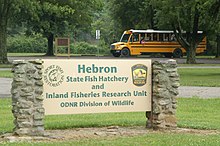
- Hebron State Fish Hatchery . Occasionally offers open houses. ( updated Nov 2018 )
Buy [ edit ]
Eat [ edit ].
- Clay's Cafe , 808 W Main St , ☏ +1 740 929-2529 , [email protected] . ( updated Dec 2018 )
Drink [ edit ]
- Mill Dam Corner Grille , 3982 National Rd , ☏ +1 740 928-3567 . Pub ( updated Dec 2018 )
Sleep [ edit ]
- 39.960085 -82.478182 1 Best Western Lakewood Hebron , 122 Arrowhead Blvd , ☏ +1 740-928-1800 .
Connect [ edit ]
- Hebron Library , 934 W Main St , ☏ +1 740 928-3923 . ( updated Dec 2018 )
Go next [ edit ]
- Has default banner
- Has mapframe
- See listing with no coordinates
- Has map markers
- Do listing with no coordinates
- Eat listing with no coordinates
- Drink listing with no coordinates
- Has routebox
- Has Geo parameter
- Greater Columbus
- All destination articles
- Usable cities
- Usable articles
- City articles
- Pages with maps
Navigation menu
Expedia Rewards is now One Key™
Things to do in hebron, visit hebron, hebron attractions.
It's no wonder so many tourists head to Hebron every year. This appealing city is packed with wonderful things to do. Whether you're fond of seeing the sights or having a go at more exhilarating experiences, you'll never be bored here.
If you're ready to discover the best of Hebron, join a few of the top tours & day trips on offer, and let an expert show you some of the most popular sights. Offering free cancellations and no added fees, our top {54 fun activities in Hebron fun activities in Hebron } are also worth browsing through.
Explore thousands of experiences from activities and attractions to day tours and transfer.
Skip the line- book tickets online in minutes to top attractions with free cancellation on many activities.
One Key members save 10% or more on select activities, hotels, cars and vacation rentals.
Recommended things to do in Hebron
What to do in hebron, things to do in hebron with kids.
You'll find loads of enjoyable things to do in Hebron with the kids. Everyone can get in on the sightseeing with these family friendly experiences :
- Cincinnati Ethnic Food and Culture Tour in Over the Rhine
- Saturday Cincy Brunch, History and Streetcar Tour
Looking for sports, concerts, or theater events in Hebron? Search event tickets to see what's happening today, or to plan what to do this weekend!
Frequently asked questions
Popular day trips from hebron.

- Places to visit
- Hotels near popular Hebron Attractions
- Nearby cities for things to do
- Expedia's Latest Trends
- Paycor Stadium
- Great American Ball Park
- Creation Museum
- Newport Aquarium
- University of Cincinnati
- Cincinnati Zoo and Botanical Garden
- Riverbend Music Center
- Hard Rock Casino Cincinnati
- Cincinnati Museum Center at Union Terminal
- Xavier University
- EastGate Mall
- Newport on the Levee
- Heritage Bank Center
- Coney Island
- Sharonville Convention Center
- Northern Kentucky University
- Fountain Square
- Kenwood Towne Centre
- Duke Energy Convention Center
- Jungle Jim's International Market
- TQL Stadium
- Hollywood Casino
- Perfect North Slopes
- Florence Mall
- Taft Theatre
- Smale Riverfront Park
- Northern Kentucky Convention Center
- MainStrasse Village
- Belterra Park Gaming and Entertainment Center
- Big Bone Lick State Park
- Rookwood Commons
- Aronoff Center for the Arts
- Cincinnati Music Hall
- Winton Woods Park
- Spring Grove Cemetery
- National Underground Railroad Freedom Center
- Cincinnati Art Museum
- Florence Speedway
- Findlay Market
- Hotels near Paycor Stadium
- Hotels near Great American Ball Park
- Hotels near Hard Rock Casino Cincinnati
- Hotels near Riverbend Music Center
- Hotels near University of Cincinnati
- Hotels near Newport Aquarium
- Hotels near Creation Museum
- Hotels near Heritage Bank Center
- Hotels near Cincinnati Zoo and Botanical Garden
- Hotels near Kenwood Towne Centre
- Hotels near Duke Energy Convention Center
- Hotels near Sharonville Convention Center
- Hotels near Xavier University
- Hotels near TQL Stadium
- Hotels near EastGate Mall
- Hotels near Taft Theatre
- Hotels near Hollywood Casino
- Hotels near Aronoff Center for the Arts
- Hotels near Big Bone Lick State Park
- Hotels near Coney Island
- Hotels near Perfect North Slopes
- Hotels near Newport on the Levee
- Hotels near Northern Kentucky University
- Hotels near Rookwood Commons
- Hotels near Fountain Square
- Hotels near Belterra Park Gaming and Entertainment Center
- Hotels near Jungle Jim's International Market
- Hotels near Northern Kentucky Convention Center
- Hotels near Smale Riverfront Park
- Hotels near Cincinnati Music Hall
- Indianapolis Activities
- Louisville Activities
- Columbus Activities
- Cincinnati Activities
- Lexington Activities
- Dayton Activities
- Bloomington Activities
- Fort Wayne Activities
- Charleston Activities
- Florence Activities
- Nashville Activities
- Mason Activities
Will northern lights be visible in Kentucky this weekend? What we know

The aurora borealis could be making its way further south above large portions of the United States because of increased solar activity, space weather experts said Friday.
Federal forecasters from NOAA's Space Weather Prediction Center said that during previous solar activity of this magnitude, the "aurora has been seen as low as Alabama and northern California." Experts say the aurora might be visible Friday, Saturday or Sunday night.
Here's what we know.
Seeing the northern lights improves after storm watch upgraded to rare G4
"This weekend's geomagnetic storm watch has been upgraded from G2 (Moderate) to G4 (Severe)," according to astronomer Tony Phillips, writing on SpaceWeather.com . "Why? Because giant sunspot AR3664 keeps hurling (coronal mass ejections) toward Earth. Following today's X2.2 solar flare , there are now at least four storm clouds heading our way," Phillips said.
The Space Weather Prediction Center only rarely issues "severe" storm watches. The last time such an alert was issued was in January 2005. "Watches at this level are very rare," the center said.
The colorful aurora forms when particles flowing from the sun get caught up in Earth's magnetic field. The particles interact with molecules of atmospheric gases to cause the famed glowing green and reddish colors of the aurora.
Will the northern lights be visible in Kentucky this weekend?
An NOAA map shows parts of Northern Kentucky are within the area that could see the aurora borealis this weekend, but it's at the very edge of the predicted zone. But just like weather on earth — especially in the Midwest — space weather can be fickle (even more so). Unlike terrestrial weather, scientists who forecast celestial events like the aurora rely on observations of the 93-million-miles-away sun to make their predictions.
Why are the northern lights appearing further south? Blame the solar maximum
The northern lights, aka the aurora borealis, have appeared more frequently in the night sky over the United States recently. In April 2023, for example, a stunning aurora display was seen as far south as Arkansas in the South and Arizona in the West.
So why the uptick in aurora sightings? And is this expected to continue? Well, if you love the aurora, you're in luck, as it may be coming to a sky near you more often over the next few years thanks to the "solar maximum," which is expected to peak this year.
"There have been an increase in aurora seen in general on Earth," Shannon Schmoll, the director of the Abrams Planetarium at Michigan State University told USA TODAY last year. "The sun has been more active, resulting in more solar storms that cause solar flares and coronal mass ejections (CME).
What's the difference between a solar flare and a coronal mass ejection?
While coronal mass ejections (CMEs) and solar flares are both tremendous explosions of energy that occur on the sun, they move at different speeds.
Solar flares, NASA says, are some of the most powerful explosions in the solar system. Particles from a solar flare can travel at the speed of light and reach Earth in minutes. CMEs, explains NASA , are large clouds of solar plasma and magnetic fields from the Sun that can take up to three days to reach our planet.
Moms, look away. Kids, here's your procrastinator's guide to Mother's Day
Tips for viewing the northern lights
"Go out at night," NOAA said. "And get away from city lights."
The best aurora is usually within an hour or two of midnight (between 10 p.m. and 2 a.m. local time). These hours expand towards evening and morning as the level of geomagnetic activity increases.
There may be aurora in the evening and morning, but it is usually not as active and therefore, not as visually appealing, NOAA said.
John Tufts covers trending news for the Indianapolis Star. Send him a news tip at [email protected] . Follow him on X at @JTuftsReports .
Microsoft buys land in Heath, apparently to build another data center

HEATH − Microsoft, which previously purchased land in Hebron, New Albany and Pataskala, is now eying Heath as well.
Heath Mayor Mark Johns confirmed Friday the company acquired property west of Thornwood Drive and south of Hallie Lane on land previously owned by Ramp Creek Estate LLC, which owned 219 acres on three parcels. The two westernmost parcels are bordered on the north by the railroad tracks.
"I can't confirm exactly what parcels were purchased, I just know that's the area," Johns said. "Based on what we know at this time, the project is like the project Microsoft is considering in Hebron."
The land, which is in the Lakewood School District, is in a pre-1994 Community Reinvestment Area, which means it qualifies for a 15-year, 100% tax abatement on the improvements made to the property.
The mayor said the city will likely host an open house for the company to present plans to the community, similar to what happened in Hebron a few months ago.
"The city was involved in conversations on the possibility of their use for that land and in preliminary discussions regarding infrastructure improvements, utilities and roads this project might need," Johns said.
Microsoft issued the following response seeking comment:
"Microsoft is planning to build datacenter campuses in Licking County, Ohio. We look forward to actively participating in the community and investing in social programs that support our goals of promoting environmental sustainability and skill development and training for meaningful employment in the technology sector.
"Typically, when we build new facilities, we estimate it will require 350 construction roles and approximately 2.2 million work hours to complete construction of the new datacenters."
In Hebron, Microsoft is in the process of acquiring 215 acres west of Ohio 79 on both sides of the village-township line, connecting to Canyon Road. The company plans six data center buildings, with an estimated 30 employees per building.
A 131-acre parcel at 323 N. High St. is being annexed from Union Township into Hebron. It is just west of Coshocton Grain, THK Manufacturing, State Industrial Products and Hendrickson Auxiliary Axle Systems. The Hebron parcel, 84 acres at 129 N. High St., is immediately south of the township land.
Hebron Mayor Valerie Mockus said, "For Hebron, it's not completed yet. We've been working with them for months now. We've pushed back on a few things."
Heath awaits a sketch review plan from the company, Johns said.
"It helps outline how the property would be developed, the number of buildings and location," Johns said. "There's multiple things that need to occur on any economic development plan in the community. I'm not surprised by their decision. I think Licking County and Heath is a great place for a business to want to locate."
In 2025, the Ohio Department of Transportation plans to improve Thornwood Drive, from Irving Wick Drive West to Lees Road.
City and county officials have been working for years on a Thornwood Drive economic development corridor, from the Thornwood Crossing interchange on Ohio 16 to Interstate 70.
A new road and bridge will connect Thornwood Crossing to Thornwood Drive in Newark, with a new roundabout under construction at Reddington Road, Thornwood Drive and a relocated River Road. Vehicles on Ohio 16 will exit onto Thornwood Crossing, travel on the new road to Thornwood Drive, south in Heath to Ridgely Tract Road, then onto Ohio 79 into Hebron and onto the interstate.
In June, Microsoft paid $56.9 million , or $310,000 per acre, for city of New Albany property between Beech Road and the Licking-Franklin county line, north of Fitzwilliam Lane NW, and less than a mile south of U.S. 62.
Last fall, the tech giant paid $30.65 million for three parcels on the north side of Refugee Road between Mink Street and Etna Parkway in the Pataskala Corporate Park. The site is believed to also be in the mix for data centers as central Ohio has become one of the top 10 regions in the country for the facilities .
740-973-4539
Twitter: @kmallett1958

IMAGES
COMMENTS
Taking a guided Hebron tour. The Dual Narrative Hebron Tour is offered by Abraham Tours every Sunday and Wednesday. It costs $85 USD. While it is not necessary to take a guided tour of the city and tourists are perfectly safe, a guided tour will give you better insights on the history and politics of the city.
Hebron (Arabic: الخليل al-Ḫalīl; Hebrew: חֶבְרוֹן Ḥevron, Ḥeḇrôn, or Ḥebron) is an ancient city in the southern West Bank. It is the traditional burial place of the Biblical patriarchs Abraham, Isaac, Jacob, and their wives. This makes it a significant religious site for the Abrahamic religions.
Book a Tour to Hebron and the West Bank Palestinian Territories. For all details and to book the Dual Narrative Tour in Hebron with one of my trip partners, Abraham Tours, can be found here. The full day tour costs 290 ILS = 69/ $78 / £61 and runs from 8 am until 7 pm. You will need your passport in order to cross through the checkpoints.
Enjoy a 2 days private tour and explore Bethlehem, Jericho and Hebron including Saint George's Monastery, the Church of …. Free cancellation. from. $974. per group. 15. Hebron Dual Narrative Tour from Jerusalem. 143. Historical Tours.
Things To Do In Hebron. Hebron, located in the Palestinian Territories, offers a variety of things to do for visitors.Bold words indicate the main attractions and activities in the city.. 1. Visit the Cave of the Patriarchs: This ancient religious site is of great significance to both Jews and Muslims.It is believed to be the burial place of Abraham, Isaac, Jacob, Sarah, Rebecca, and Leah.
Hebron Glass & Ceramics. 14. Speciality & Gift Shops. Established in 1890, a family business located in the historic West Bank city of Hebron, well-known for its Handmade Ceramics and traditional hand blown Glass. See full details. See ways to experience (4) 11. Al Saeed For Herbs And Spices. Speciality & Gift Shops.
The Dual Narrative Hebron Tour is offered through Abraham Tours, with whom I partnered with for the duration of my Israel and Jordan trip. The tour is offered from Jerusalem and requires using public transit (a bulletproof bus) to get to and from the city of Hebron. It is a full day tour that does require quite a bit of walking (there are a ...
The Al-Amanah Hotel or sometimes called the " Hebron Hotel ". It is in Ein Sarah Street and 5 minutes away from the city center "Bab El Zawyieh". You can check with the hotel management about the availability of rooms and prices by email: [email protected] or phone: +972 2 225 4240.
Gain a better understanding of the conflict between Israel and Palestine on this dual-guided, full-day tour of Hebron in the West Bank. The city is divided into two sectors: one is controlled by the Palestinian National Authority and the other by Israel. Explore both, first with an Israeli-Jewish guide, then with a Palestinian guide. Learn about the struggles in this Middle Eastern city. Visit ...
Uncover Hebron's best with our Travel Guide for 2024. Expert tips & must see recommendations. Whether a tourist or local, plan your holiday today with this tourist guide!
Hebron, NE 68370. Sandwiches. REQUEST OUR TRAVEL GUIDE; ENEWSLETTER SIGN-UP; Nebraska Passport; Group Travel; Industry; Press; Commission; Contact; GDPR FAQ; Official Nebraska Government Website Nebraska Tourism Commission 301 Centennial Mall South PO Box 98907 Lincoln, NE 68509-8907 (402) 471-3796.
Travel guide resource for your visit to Hebron. Discover the best of Hebron so you can plan your trip right. Skip to Main Content. Shop travel. Shop travel. Stays Stays. ... the people in Hebron wonderful and the location is on a main business street that basically has everything. Strongly recommended." Reviewed on Jan 3, 2023. Get rates.
Hebron, the largest city in the West Bank, is located in the south of the region. In case you didn't know, Palestine is divided into two regions: the West Bank and the Gaza Strip, both separated by the state of Israel. Hebron is home to the Cave of the Patriarchs, the place where Abraham, Sarah, Isaac, Rebecca, Jacob, and Leah are buried ...
Hebron. Follow Cam Mackintosh in the guise of The Wanderer, as he dives into the fascinating emirate of Abu Dhabi. Explore each step of his travel guide among deserts' hidden gems. Follow along on his epic journey.
Read travel guides & discover the best attractions to see and the best restaurants to eat at in Hebron. Log in; Sign up. Log in; Sign up. Hebron. Hebron is a Palestinian city in the southern West Bank, 30 kilometres south of Jerusalem. Nestled in the Judaean Mountains, it lies 930 metres above sea level.
All the best things to do in Hebron. Know the popular attractions & nearby tourist places to visit. Pro tips for food, stays, activities, transport & shopping.
1 Hebron Post Office. (updated Feb 2019) Go next [edit] Routes through Hebron: Sharonville ← Lawrenceburg ← W E → Erlanger → Milford-Miami Township: This city travel guide to Hebron is an outline and needs more content. It has a template, but there is not enough information present. Please plunge forward and help it grow! Retrieved ...
If you're looking for the very warmest time to visit Hebron, the hottest months are August, July, and then September. See average monthly temperatures below. The warmest time of year is generally early August where highs are regularly around 89.1°F (31.7°C) with temperatures rarely dropping below 70.2°F (21.2°C) at night.
Holiday Inn Cincinnati Airport, an IHG Hotel. 1717 Airport Exchange Blvd, Hebron, KY. Fully refundable Reserve now, pay when you stay. $98. $110 total. includes taxes & fees. Apr 30 - May 1. Stay at this business-friendly hotel in Hebron. Enjoy free WiFi, breakfast, and a free airport shuttle.
Hebron. Filter Results. Filter Results. Type. Attractions & Entertainment (1) History (3) Nature & Outdoor Activities (1) Places to Stay (2) Browse Properties. Results 1 - 5 of 5 Sort by. Southwest. Campgrounds & RV Parks. Brick City Campground ... Order Travel Guide; E-News Sign-Up;
Sleep. 39.960085 -82.478182. 1 Best Western Lakewood Hebron, 122 Arrowhead Blvd, ☏ +1 740-928-1800. edit.
Cincinnati Streetcar Food Tour With Findlay Market. Built on Beer Tour. Under $25. Distillery Tour at Second Sight Spirits with Spirits Tasting. Cincinnati Scavenger Hunt: True America. Cincinnati City Scavenger Hunt Excursion by Wacky Walks. Adventurous Scavenger Hunt in Cincinnati by 3Quest Challenge.
Travel Agency. Long Business Description. Nancy Palinski. 61-B Main Street. Hebron, CT 06248. Business Phone Number. 860-228-8221. Business Fax. 860-228-8223.
An NOAA map shows parts of Northern Kentucky are within the area that could see the aurora borealis this weekend, but it's at the very edge of the predicted zone. But just like weather on earth ...
Vehicles on Ohio 16 will exit onto Thornwood Crossing, travel on the new road to Thornwood Drive, south in Heath to Ridgely Tract Road, then onto Ohio 79 into Hebron and onto the interstate.